2. 中国科学院地球科学研究院, 北京 100029;
3. 中国科学院大学, 北京 100049;
4. 长安大学地球科学与资源学院, 西安 710054;
5. 哈萨克斯坦沙特巴耶夫地质研究所地层实验室, 阿拉木图 050010
2. Institute of Earth Science, Chinese Academy of Sciences, Beijing 100029, China;
3. University of Chinese Academy of Sciences, Beijing 100049, China;
4. College of Earth Sciences, Chang'an University, Xi'an 710054, China;
5. Laboratory of Geological Formations, K. Satpaev Institute of Geological Sciences, Almaty 050010, Kazakhstan
中亚成矿域是世界上斑岩型铜矿的重要产地之一,发育许多古生代大型-超大型斑岩型铜矿(图 1),但多集中分布在中亚成矿域西段,其中仅哈萨克斯坦境内产出的百万吨级以上矿床就达十余处(表 1),如波谢库尔(Bozshakol)、努尔卡斯甘(Nurkazgan)、科翁腊德(Kounrad)、阿克斗卡(Aktogai)和科克赛(Koksai)等超大型(>2Mt Cu,Singer,1995)斑岩铜矿(Yakubchuk et al., 2012;申萍等,2015;图 2)。

|
图 1 中亚造山带(CAOB)构造简图和巨型斑岩铜矿分布图(据Shen et al., 2016修改) Fig. 1 Schematic tectonic map of the Central Asian Oroganic Belt (CAOB) showing the locations of the giant porphyry Cu deposits (modified after Shen et al., 2016) |
|
|
表 1 哈萨克斯坦境内主要百万吨级斑岩型铜矿床(数据据Yakubchuk et al., 2012) Table 1 Porphyry Cu deposits with megaton copper resource in Kazakhstan (data from Yakubchuk et al., 2012) |

|
图 2 中哈萨克斯坦地质简图和主要岩浆热液矿床分布图(据Abdulin et al., 1996; Windley et al., 2007;李光明等,2008; Shen et al., 2016修改) Fig. 2 Simplified geological map of Central Kazakhstan showing the locations of the mainly magmatic hydrothermal deposits (modified after Abdulin et al., 1996;Windley et al., 2007;Li et al., 2008;Shen et al., 2016) |
努尔卡斯甘斑岩型铜矿也名萨玛尔斯克矿床(Samarsk或Samarka;Zhukov et al., 1997;李光明等,2008;毛景文等,2014;Seltmann et al., 2014),位于中哈萨克斯坦北缘卡拉达干州北西38km处(图 2),属于典型早古生代(440~437Ma,Shen et al., 2016)富金斑岩铜矿床(>0.4g/t Au,Sillitoe,2000;李金祥等,2006)。1995年,Kazminco首次报道努尔卡斯甘矿床估计矿石资源量为81Mt(1.33% Cu、0.52g/t Au),之后Kazakhmys通过调查角砾岩筒深部延伸情况将矿石量增加至200.6Mt (0.89% Cu、0.39g/t Au和2.64g/t Ag;Yakubchuk et al., 2012)。到2011年,进一步勘探工作取得重大突破,在原西努尔卡斯甘矿段的基础上,发现了北努尔卡斯甘矿段近地表低品位矿化和东努尔卡斯甘及东南努尔卡斯甘矿段高品位、网脉状隐伏矿化,进而总矿化面积增为6×3km2(图 3a),总矿石资源量增至516.87Mt(0.78% Cu、0.45g/t Au),铜和金资源量扩为超大型规模(表 1;Yakubchuk et al., 2012)。而且,随着探勘工作的进行,铜和金资源量仍还有望被继续扩大(Yakubchuk et al., 2012)。空间上,努尔卡斯甘富金斑岩铜矿还紧密伴生有浅成低温热液金矿床(图 3a;Zhukov et al., 1997;李光明等,2008;Seltmann et al., 2014),为中亚成矿域西段斑岩-浅成低温套合成矿体系的典型代表(李光明等,2008)。因此,对其研究可为认识早古生代斑岩铜金矿-浅成低温热液金矿成矿体系提供宝贵资料。
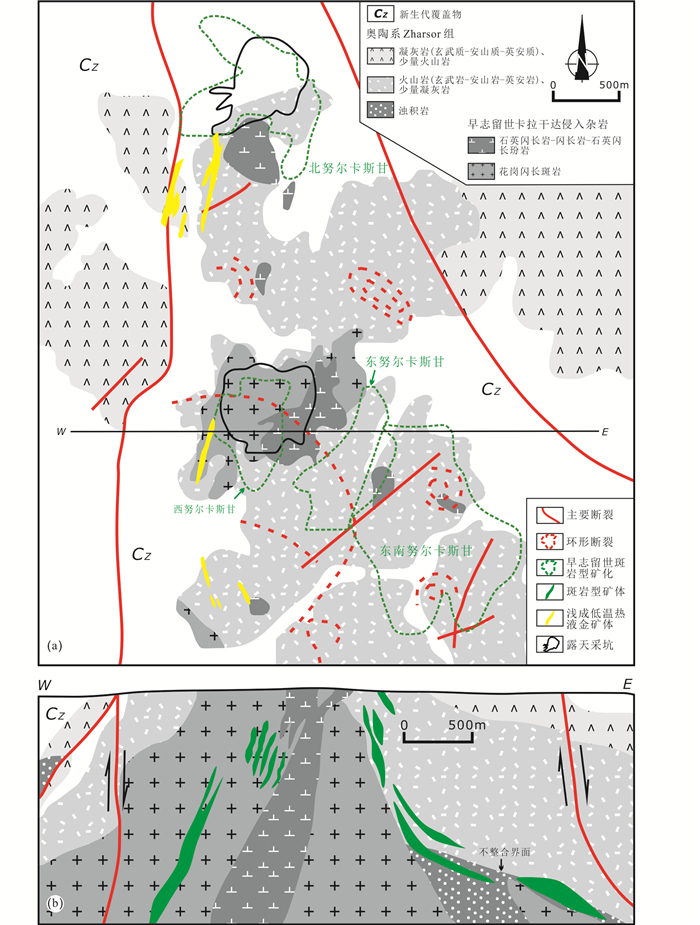
|
图 3 努尔开斯甘富金斑岩型铜矿矿区地质简图(据Zhukov et al., 1997;李光明等,2008;Yakubchuk et al., 2012;Shen et al., 2016修改) Fig. 3 Geological map of the Nurkazghan gold-rich porphyry copper deposit (modified after Zhukov et al., 1997;Li et al., 2008;Yakubchuk et al., 2012;Shen et al., 2016) |
前人已经对努尔卡斯甘矿床进行了较多研究工作,并取得了较大进展,主要集中在岩石学、岩石地球化学、成岩时代及构造背景等方面(Zhukov et al., 1997;Heinhorst et al., 2000;Seltmann and Porter, 2005;Windley et al., 2007;李光明等,2008;Seltmann et al., 2014;Yakubchuk et al., 2012;Shen et al., 2016),矿床地质特征方面也有所涉及(Zhukov et al., 1997;李光明等,2008;Seltmann et al., 2014;Yakubchuk et al., 2012),但缺乏对金赋存状态研究。本文在前人研究的基础上,通过岩相学、矿相学和扫描电镜观察以及电子探针分析等手段,对努尔卡斯甘富金斑岩铜矿的基本地质特征和金赋存状态进行了细致研究,期望为努尔卡斯甘斑岩铜金矿床研究的进一步深入奠定基础。由于目前勘探工作还在进行,现在的认识可能将被进一步修订。
1 成矿地质背景努尔卡斯甘斑岩铜金矿床地处中亚造山带中西段,位于中哈萨克斯坦成矿省北缘奥陶纪Erementau-Yili增生楔(缝合带)内(Windley et al., 2007;图 2),形成于洋内弧环境(Shen et al., 2016)。在前寒武纪微陆块和主要岛弧拼贴拼贴完全形成哈萨克斯坦大陆之前(晚志留世,Windley et al., 2007),在数十个百万年内,广阔的准噶尔-巴尔克什大洋发生洋内俯冲增生,且由于弧岩浆作用和增生前缘持续向海一侧迁移,造成俯冲带的回撤。最终,这一洋内俯冲消减洋盆宽度达数百到数千千米,并形成了Erementau-Yili巨型增生楔(Windley et al., 2007)。同时,伴随这一洋内俯冲增生过程,努尔卡斯甘含矿弧岩浆在早志留世侵位到Erementau-Yili增生楔中,造就了铜金矿化(Shen et al., 2016)。
2 矿区地质特征努尔卡斯甘铜金矿床矿区出露地层简单,为奥陶系Zharsor组,主要岩性包括由玄武岩、安山岩和少量英安岩组成的火山岩、玄武质-安山质凝灰岩和安山质-英安质凝灰岩。该地层在矿区形成背斜构造(Zhukov et al., 1997;李光明等,2008),其内断裂发育,主要表现为近南北向和北西向的两条大断裂、次一级北东-北北东向断裂和环形断裂(图 3a)。
地表出露岩浆岩为早志留世卡拉干达花岗岩类杂岩体。杂岩体从背斜核部侵入到Zharsor组地层中(图 3),由花岗花岗闪长斑岩和石英闪长玢岩、石英闪长岩和少量闪长岩组成。花岗闪长斑岩出露于矿区中部西努尔卡斯甘矿段,呈岩株状产出。石英闪长玢岩脉-石英闪长岩-闪长岩侵入到花岗花岗闪长斑岩体内,主要出露于矿区北部和中部(图 3)。目前,石英闪长玢岩、石英闪长岩和闪长岩之间的时空关系还不清楚。所有这些岩体都发育强烈热液蚀变和不同程度硫化物矿化,均为含矿岩体。
花岗闪长斑岩为斑状结构,块状构造,斑晶由斜长石(可见环带结构)、钾长石、黑云母和石英组成(含量约30%~40%,粒径1~2mm;图 4a),其中长石已部分或完全蚀变为伊利石(±绿泥石±碳酸盐),黑云母已蚀变为绿泥石,基质组成与斑晶相似。石英闪长玢岩为斑状结构,块状构造,斑晶由斜长石和少量角闪石、黑云母、石英组成(含量约50%~60%,粒径1~3mm;图 4b),基质包含斜长石和少量石英,斜长石基本上已经完全蚀变为伊利石、绢云母或绿泥石,黑云母和绝大多数角闪石发生了强烈绿泥石化,可见极少数已局部黑云母化的角闪石。石英闪长岩为半自形结构,粒径1~2mm,块状构造,由斜长石、角闪石、黑云母和少量石英组成(图 4c),副矿物含有榍石和磁铁矿,其中斜长石已局部或完全发生了钾长石化或伊利石化,角闪石已遭受阳起石化或绿泥石化、绿帘石化,黑云母部分发生绿泥石化。闪长岩为半自形结构,粒径1~2mm,块状构造,由斜长石和少量角闪石、辉石组成(图 4d),也已发生了一定程度热液蚀变。
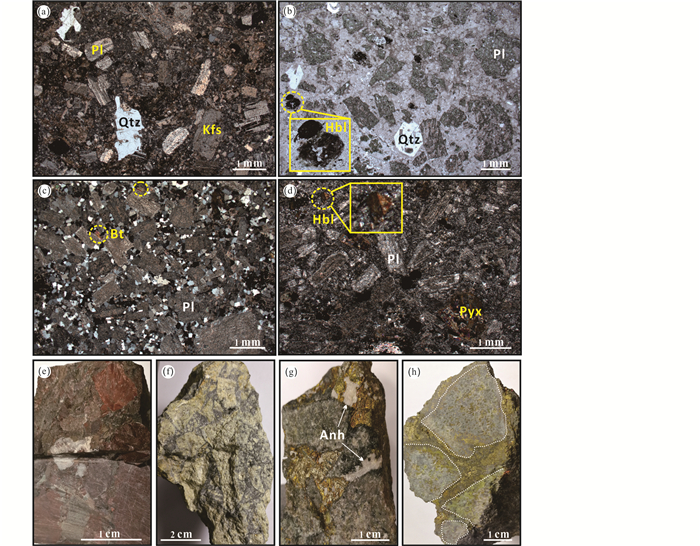
|
图 4 努尔卡斯甘富金斑岩型铜矿含矿岩体和热液角砾岩照片 (a)花岗闪长斑岩(12HS03-1);(b)石英闪长玢岩(12HS01-3),斜长石和一些角闪石斑晶已发生强烈绿泥石化蚀变;(c)石英闪长岩(12HS05-4);(d)闪长岩(12HS04-8);(e) Type 1型热液角砾岩,基质主要为火山岩碎片,极少方解石和硬石膏等热液矿物(12HS04-2);(f) Type 2型热液角砾岩,角砾为强绢云母化和硅化花岗闪长斑岩,胶结物为主要为电气石、石英和少量黄铁矿(12HS01-1);(g) Type 2型热液角砾岩,角砾为强中级泥化石英闪长岩,胶结物为硬石膏和黄铜矿、黄铁矿(12HS04-21);(h) Type 3型热液角砾岩,角砾已发生强中级泥化蚀变,胶结物为完全为黄铜矿(12HS02-18). (a-d)正交偏光;(e-h)自然光. Anh-硬石膏;Bt-黑云母;Hbl-角闪石;Kfs-钾长石;Pl-斜长石;Pyx-辉石;Qtz-石英 Fig. 4 Photographs of ore-bearing intrusions and hydrothermal breccias in Nurkazghan gold-rich porphyry copper deposit (a) granodiorite porphyry (12HS03-1);(b) quartz diorite porphyrite (12HS01-3) in which plagioclase and some hornblende have been mainly replaced by chlorite; (c) quartz diorite (12HS05-4);(d) diorite (12HS04-8);(e) Type 1 hydrothermal breccias with matrix mainly consisting of volcanic clasts (12HS04-2);(f) Type 2 hydrothermal breccias with sericitic granodiorite porphyry fragment and hydrothermal matrix consisting of abundant tourmaline and quartz and minor pyrite (12HS01-1);(g) Type 2 hydrothermal breccias with intermediate argillic quartz diorite fragment and anhydrite-chalcopyrite-pyrite matrix (12HS04-21);(h) Type 3 hydrothermal breccias with strongly intermediate argillic fragment cemented by chalcopyrite (12HS02-18). (a-d) under crossed polarize light; (e-h) under nature light. Abbreviations: Anh-anhydrite; Bt-biotite; Hbl-hornblende; Kfs-K-feldspar Pl-plagioclase Pyx-pyroxene Qtz-quartz |
矿区还发育热液角砾岩,位于花岗闪长斑岩体内(Yakubchuk et al., 2012),角砾大小数厘米不等、呈不规则状或次圆状,来自火山岩、凝灰岩和、花岗闪长斑岩和石英闪长岩等,胶结物为石英、硬石膏、绿泥石、电气石、黄铁矿和黄铜矿等热液矿物。根据胶结物组成可分为3类,①Type 1:胶结物主要为小角砾(粒径通常不超过1cm)和极少量热液矿物(图 4e);②Type 2:胶结物为石英、电气石、硬石膏和绿泥石以及磁铁矿、金属硫化物等热液矿物(图 4f, g);③Type 3:胶结物几乎全部由黄铁矿、黄铜矿等硫化物组成,缺乏石英、硬石膏等透明热液矿物(图 4h)。这些热液角砾岩与铜金矿化密切相关,尤其是Type 2和Type 3型角砾岩为努尔卡斯甘铜金矿床的重要矿化类型(Yakubchuk et al., 2012;Seltmann et al., 2014)。在北努尔卡斯甘和西努尔卡斯甘矿段,热液角砾岩广泛分布于闪长岩和石英闪长岩中,与石英闪长岩之间呈渐变过渡关系(Shen et al., 2016)。
3 矿体地质特征努尔卡斯甘富金斑岩型铜矿发育浸染状、网脉状或角砾状矿化(图 4g, h),其中矿化热液角砾岩丰富为其显著特征之一。但是,不同矿段,角砾状矿化发育程度有所不同,在北努尔卡斯甘和西努尔卡斯甘矿段,矿化角砾岩筒为矿体的重要组成部分(Zhukov et al., 1997;李光明等,2008;Shen et al., 2016),而东南努尔卡斯甘矿段主要发育隐伏网脉状高品位矿化(0.94% Cu、0.7g/t Au)(地表以下600-1200m深度,图 3b;Yakubchuk et al., 2012)。
3.1 矿体形态和产状矿体赋存在花岗闪长斑岩体内及其外接触带火山岩中(图 3b)。在西努尔卡斯甘矿段(中矿段,Zhukov et al., 1997;李光明等,2008),矿体产于花岗闪长斑岩内,整体上呈岩株状,从中可分出透镜状富矿体。富矿体向西和南西陡倾,基本上与花岗闪长斑岩和石英闪长玢岩-石英闪长岩-闪长岩接触带平行(Yakubchuk et al., 2012;Shen et al., 2016)。东努尔卡斯甘矿段中,透镜状富矿体向西陡倾,沿花岗闪长斑岩外接触带分布在Zharsor组火山岩地层之中。东南努尔卡斯甘矿段中,透镜状富矿体呈缓倾斜产于花岗闪长斑岩外接触带,沿地层不整合接触面分布(Yakubchuk et al., 2012)。此外,石英闪长玢岩-石英闪长岩-闪长岩及其相关角砾岩筒中也发育铜金矿体(Seltmann et al., 2014)。而且,我们的研究也发现它们发育明显热液蚀变和铜金矿化(详见下文)。因此,石英闪长玢岩-石英闪长岩-闪长岩与花岗闪长斑岩一样,也属于含矿岩体,而并非如以往图件资料(如图 3b)所示它们为贫矿化。
3.2 矿物组成及组构各矿段矿体矿石矿物和脉石矿物组成基本上相同。矿石矿物主要为黄铜矿、磁铁矿和黄铁矿,发育赤铁矿和金红石,少量斑铜矿、蓝辉铜矿、黝铜矿、辉钼矿、自然金、银金矿、辉银矿、方铅矿和闪锌矿等。磁铁矿分为粒状和板状2种形式(图 5a, b),与铜金矿化关系密切(图 5c-f)。不规则粒状磁铁矿见于钾钙硅酸盐化、青盘岩化(图 6k)、中级泥化蚀变岩以及早期磁铁矿细脉(M脉,图 7a, b)中,板状磁铁矿赋存在中级泥化蚀变岩和相关角砾岩中,与硬石膏、绿泥石等伴生,并可被黄铜矿包裹(图 5b, e)。金红石多呈不规则粒状,也可呈针状分布在角闪石解理缝中或细脉状(图 7k)。空间上一些粒状金红石可与黄铜矿相共生或出现相互包裹现象,暗示其与黄铜矿同时发生沉淀。黄铜矿为主要含铜矿物,呈不规则他形分布于蚀变岩、石英脉、硬石膏脉及热液角砾岩中,空间上可与磁铁矿和黄铁矿共生(图 5h)、被其包裹(图 5f)或充填其内部裂隙(图 5i),也可与斑铜矿(图 5g)、黝铜矿和闪锌矿相伴生,还可被蓝辉铜矿所交代(图 5j)。辉钼矿极少,呈自形结晶片状、鳞片状、花瓣状或花瓣状集合体,常与黄铁矿伴生(图 5k)。
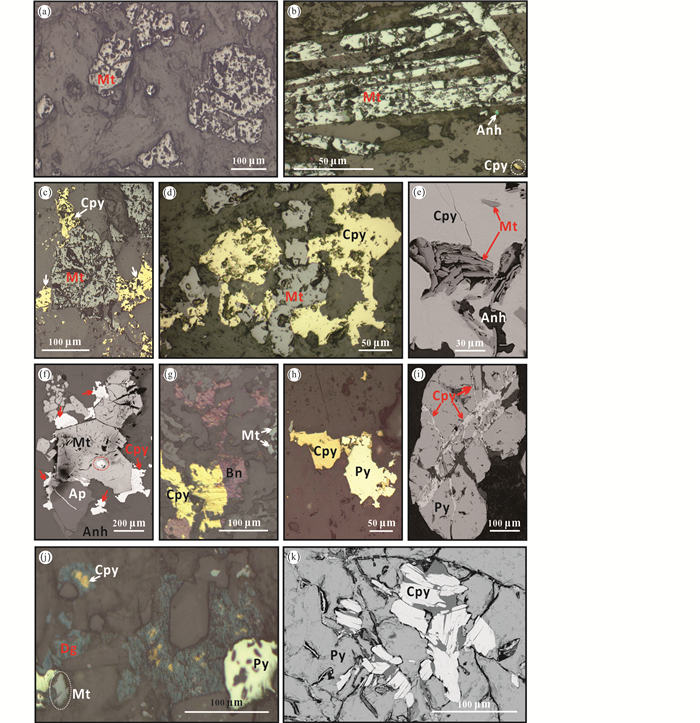
|
图 5 努尔卡斯甘富金斑岩型铜床矿石矿物显微照片 (a)钾钙硅酸盐化石英闪长岩中的浸染状磁铁矿(12HS04-12;反射光);(b)中级泥化角砾岩中长柱状磁铁矿与细粒黄铜矿和硬石膏伴生(12HS05-6;反射光);(c)钾钙硅酸盐化石英闪长岩中黄铜矿与磁铁矿紧密共生(12HS04-10;反射光);(d)中级泥化蚀变岩中黄铜矿与磁铁矿共生(12HS04-15;反射光);(e)与中级泥化相关的矿化热液角砾岩中黄铜矿胶结物包裹板状磁铁矿和少量硬石膏(12HS04-13;背散射);(f)与中级泥化相关的矿化热液角砾岩中黄铜矿与自形粒状热液磁铁矿共生、被其包裹,并充填热液磷灰石中微裂隙(12HS04-13;背散射);(g)钾钙硅酸盐化石英闪长岩中斑铜矿与黄铜矿共生(12HS04-12;反射光);(h)花岗闪长斑岩角砾中黄铜矿与黄铁矿共生(12HS03-4;反射光);(i)中级泥化花岗闪长斑岩中黄铜矿沿黄铁矿内微裂隙充填交代(12HS02-11;背散射);(j)中级泥化石英闪长岩中蓝辉铜矿不完全交代黄铜矿(12HS03-3;反射光);(k)自形片状辉钼矿赋存于黄铁矿中(12HS03-5;背散射). Ap-磷灰石;Bn-斑铜矿;Cpy-黄铜矿;Dg-蓝辉铜矿;Mt-磁铁矿;Mot-辉钼矿;Py-黄铁矿 Fig. 5 Photomicrographs of ore minerals at the Nurkazgan gold-rich porphyry copper deposit (a) disseminated magnetite in quartz diorite with potassic-calcic silicate alteration (12HS04-12; reflected light); (b) tabular magnetite and nearby fine-grained anhydrite and chalcopyrite in hydrothermal breccias with intermediate argillic alteration (12HS05-6; reflected light); (c) chalcopyrite and intergrown magnetite in quartz diorite with potassic-calcic silicate alteration (12HS04-10; reflected light); (d) chalcopyrite associated with magnetite in intermediate argillic rocks (12HS04-15; reflected light); (e) tabular magnetite and minor anhydrite as encapsulated grains in chalcopyrite cement from mineralized hydrothermal breccias with intermediate argillic alteration (12HS04-13; SEM-BSE); (f) chalcopyrite is closely associated with euhedral magnetite as intergrown and encapsulated grains and it also fills within a microfracture in apatite in hydrothermal cement of mineralized hydrothermal breccias with intermediate argillic alteration (12HS04-13; SEM-BSE); (g) bornite and intergrown chalcopyrite in quartz diorite with potassic-calcic silicate alteration (12HS04-12; reflected light); (h) chalcopyrite is closely associated with pyrite in granodiorite porphyry fragment (12HS03-4; reflected light); (i) chalcopyrite has formed within microfractures in pyrite from intermediate argillic granodiorite porphyry (12HS03-4; reflected light); (j) digentite incompletely replace chalcopyrite at the margins in intermediate argillic granodiorite porphyry (12HS03-3; reflected light); (k) euhedral flake molybdenite within pyrite (12HS03-5; SEM-BSE). Abbreviations: Ap-aptatite; Bn-bornite; Cpy-chalcopyrite; Dg-digentite; Mt-magnetite; Mot-molybdenite; Py-pyrite |

|
图 6 努尔卡斯甘富金斑岩型铜矿床热液蚀变显微照片 (a)石英闪长岩中钾长石化和阳起石化蚀变(12HS05-2;正交偏光);(b)石英闪长玢岩中角闪石发生黑云母化(红棕色)蚀变(12HS04-3;单偏光);(c)石英闪长岩中钾长石化、硅化(单偏光)和少量钠长石化(虚线方框部分及其左下角内图正交图像)蚀变(12HS05-2);(d)石英闪长岩中斜长石发生钾长石化和硬石膏化蚀变(12HS05-2;正交偏光);(e)热液钾长石发生绿泥石化和碳酸盐化蚀变(12HS04-20;单偏光);(f)绿泥石化,黄铜矿与之关系密切(12HS05-6;单偏光);(g)石英闪长岩中伊利石化、绿泥石化和硬石膏化蚀变(12HS04-5;正交偏光);(h)石英闪长玢岩中强碳酸盐化蚀变(12HS04-6;正交偏光);(i)热液角砾岩基质中的电气石化蚀变(12HS03-4;正交偏光);(j)绢云母化、硅化、黄铁矿化和少量硬石膏化蚀变(12HS04-14;正交偏光);(k)石英闪长岩中绿泥石和绿帘石化蚀变(12HS05-1;正交偏光).Ab-钠长石;Act-阳起石;Cb-碳酸盐;Chl-绿泥石;Ep-绿帘石;Ill-伊利石;Ser-绢云母;Tur-电气石 Fig. 6 Photomicrographs showing hydrothermal alteration at the Nurkazgan gold-rich porphyry copper deposit (a) potash feldspathization and actinolitization in quartz diorite (12HS05-2; under CPL); (b) reddish brown biotite incompletely replace hornblende in quartz diorite porphyrite (12HS04-3; under PPL); (c) potash feldspathization and silication (under PPL) and weak albitization showed by the inner image in left bottom under CPL which represents the picture in the black dashed box (12HS04-3);(d) magmatic plagioclase in quartz diorite has been replaced by hydrothermal k-feldspar and anhydrite (12HS05-2; under CPL); (e) chlorite and carbonate incompletely replace hydrothermal K-feldspar (12HS04-20; under PPL); (f) chloritization and associated chalcopyrite mineralization (12HS05-6; under PPL); (g) illitization and chloritization with mionr hydrothermal anhydrite in quartz diorite (12HS04-5; under CPL); (h) strong carbonatization within quartz diorite porphyrite (12HS04-6; under CPL); (i) tourmalinization and pyritization in matrix from hydrothermal breccias (12HS03-4; under CPL); (j) sericitization, silication and pyritization with minor hydrothermal anhydrite under (12HS04-14; under CPL); (k) epidotization and chloritization in quartz diorite (12HS05-1; under CPL). Abbreviations:Ab-albite; Act-actinolite; Cb-carbonate; Chl-chlorite; Ep-epidote; Ill-illite; Ser-sericite; Tur-tourmaline |

|
图 7 努尔卡斯甘富金斑岩型铜矿床热液脉照片 (a)石英闪长岩中磁体矿细脉(M型脉)(手标本;12HS05-3);(b)石英闪长岩中磁铁矿-硬石膏细脉(M型脉)和图 7c位置(手标本;12HS05-2);(c)磁铁矿-硬石膏细脉(M型脉)背散射图像(12HS05-2);(d)硬石膏-黄铜矿-黄铁矿脉(D型脉)穿切钾钙硅酸盐化石英闪长岩,并发育绿泥石-伊利石组成的深绿色蚀变晕(手标本;12HS05-2A);(e)二期热液脉和图 7f位置(手标本;12HS05-3):早期硬石膏脉(D型脉)穿切含黄铜矿(左下角放大图)的钾钙硅酸盐化石英闪长岩,发育浅绿色伊利石蚀变晕.之后,此脉再次裂开并被石英-硬石膏-黄铜矿-黄铁矿细脉(D型脉)充填形成细脉(右下角放大图),但局部仍还留有空洞,脉侧伴生灰白色绢云母晕;(f)石英-硬石膏-黄铜矿-黄铁矿细脉(D型脉)脉侧绢云母晕显微照片(12HS05-3;正交偏光);(g)石英-硬石膏-绿泥石-黄铜矿脉(C型脉)穿切石英-黄铜矿细脉(B型脉)、绿泥石-黄铜矿细脉(C型脉)和图 7f位置(手标本;12HS04-15);(h)石英-黄铜矿细脉(B型脉),黄铜矿呈不连续状分布在脉中央(12HS04-15;反射光);(i)黄铁矿细脉(D型脉)穿切绿泥石脉(C型脉)(12HS03-5;单偏光);(j)四期穿插脉(手标本;12HS04-14),从早到晚:①石英-硬石膏-黄铁矿脉(B型脉);②硬石膏-黄铁矿细脉(B型脉);③黄铁矿-硬石膏细脉(D型脉);④硬石膏-黄铁矿脉(B型脉);(k)石英-金红石脉(R型脉)(12HS03-3;单偏光). Rt-金红石 Fig. 7 Photographs of hydrothermal veins in Nurkazghan gold-rich porphyry copper deposit (a) magnetite veinlet (M-type) in quartz diorite (hand specimen; 12HS05-3);(b) magnetite-anhydrite veinlet (M-type) in quartz diorite and the location of figure 7c (hand specimen; 12HS05-2);(c) SEM-BSE image of the part of magnetite-anhydrite veinlet (12HS05-2);(d) anhydrite-chalcopyrite-pyrite vein (D-type) cut through potassic-calcic quartz diorite and is accompanied by green alteration halo consisting of chlorite and illite (hand specimen; 12HS05-2A); (e) the location of Fig. 7f and two hydrothermal veins:earlier anhydrite vein (D-type) with light green illite selvage which has cut through bearing-chalcopyrite potassic-calcic quartz diorite (enlarge image at the left bottom) has opened again and later has been partly filled to form quartz-anhydrite-chalcopyrite-pyrite veinlet (D-type) with some cavities and off-white sericite halo (enlarge image at the right bottom) (hand specimen; 12HS05-3);(f) photomicrographs of quartz-anhydrite-chalcopyrite-pyrite veinlet (D-type) showing the accompanied alteration halo of sericite (12HS05-3; under CPL); (g) the location of Fig. 7h and earlier chlorite-chalcopyrite (C-type) and quartz-chalcopyrite veinlets (B-type) with later quartz-anhydrite-chlorite-chalcopyrite vein (C-type) (hand specimen; 12HS04-15);(h) photomicrographs quartz-chalcopyrite veinlets (B type) show that chalcopyrite has occurred in the central of the veinlet (12HS04-15; reflected light); (i) chlorite vein (C-type) has been cut by pyrite veinlet 12HS03-5; under PPL); (j) four hydrothermal veins from early to late (hand specimen; 12HS04-14):①quartz-anhydrite-pyrite veinlet (B-type); ②anhydrite-pyrite veinlet (B-type); ③pyrite veinlet (D-type); ④anhydrite-pyrite vein (B-type); (k) quartz-rutile vein in quartz diorite with intermediate argillic alteration (12HS03-3; under PPL). Abbreviations: Rt-rutile |
脉石矿物有钾长石、石英、绢云母、伊利石、绿泥石、绿帘石、碳酸盐(方解石和菱铁矿等)、硬石膏、电气石、钠长石、阳起石、黑云母及磷灰石等。其中,热液硬石膏发育,为努尔卡斯甘铜金矿床的另一特色,其呈浸染状(图 6d, g)、脉状(图 7d, g, k;表 2)或角砾胶结物(图 4g)的形式产出于钾化带、中级泥化带和绢云母化带中。浸染状硬石膏常交代斜长石,与石英、钾长石、伊利石或绢云母等伴生;脉状硬石膏胶结物常与石英、绿泥石、硫化物及磁铁矿共生。
|
|
表 2 努尔卡斯甘富金斑岩型铜矿热液脉系特征 Table 2 Characteristics of the hydrothermal veins from Nurkazgan gold-rich porphyry copper deposit |
矿石的结构有全自形粒状结构:如自形黄铁矿和辉钼矿;半自形粒状结构:如与磁铁矿和黄铜矿共生的黄铁矿;他形粒状结构:较为常见,呈浸染状分布的磁铁矿、黄铜矿、黄铁矿和斑铜矿等;包含结构:以黄铁矿包含细粒黄铜矿较常见,其次有黄铜矿包裹银金矿(见7.2.2章节)和方铅矿颗粒;交代残余结构:黄铁矿或蓝辉铜矿对黄铜矿交代不完全;充填交代结构:黄铜矿或方铅矿沿黄铁矿内微裂隙进行充填交代(图 5i)。矿石构造主要有浸染状构造、脉状构造和角砾状构造(图 4f-h)。
4 热液蚀变与热液脉系 4.1 热液蚀变特征矿区热液蚀变强烈,目前识别出蚀变类型包括磁铁矿化、阳起石化、钠长石化、钾长石化、黑云母化、硬石膏化、绿泥石化、绿帘石化、伊利石化、绢云母化、硅化、碳酸盐化、电气石化及黄铁矿化等。根据不同蚀变组合,可分为钾钙硅酸盐化、青磐岩化、中级泥化和绢云母化(Sillitoe,2000;李金祥等,2006;Sillitoe et al., 2013)。
钾钙硅酸盐化:主要表现为钾长石化、黑云母化和阳起石化,并伴生硅化、磁铁矿化、硬石膏化和少量钠长石化。钾长石化、阳起石化和极少量黑云母化发现于石英闪长岩中,阳起石呈放射状或纤维状,与热液钾长石和硬石膏伴生(图 6a),有些局部已经发生绿帘石化蚀变,有时还可被磁铁矿-硬石膏脉微细脉(M脉)穿切。钾长石以弥散状最为主要,其交代粗粒板柱状斜长石(图 6d),紧贴斜长石边部或穿切其生长,或与许多次生石英紧密伴生于斜长石晶隙之间(图 6c),同时造成一些斜长石发育少量钠长石净边(图 6c)。钾长石化还见于花岗闪长斑岩中,但由于后期长石破坏蚀变交代叠加作用,仅能见到一些热液钾长石残留,而是否发育次生黑云母蚀变则已经难以辨识。在强绿泥石化石英闪长玢岩中,局部可见少量黑云母化,呈细小鳞片状交代角闪石(图 6b)。
中级泥化:发育广泛,见于所有含矿岩体和热液角砾岩中,特征蚀变矿物为绿泥石、伊利石、绢云母和碳酸盐(图 6e-h)。同时,还伴生丰富的硬石膏,少量磷灰石和金红石(图 7k)。长石完全或大部分被伊利石±绿泥石和碳酸盐代替(图 6e),黑云母和角闪石蚀变为绿泥石,并发育绿泥石细脉(图 7g)。某些被硬石膏-黄铜矿-黄铁矿细脉穿切的强钾钙硅酸盐化石英闪长岩中,伊利石、绿泥石和少量碳酸盐蚀变沿细脉两侧分布,形成明显的绿色蚀变晕(图 7d),指示中级泥化蚀变晚于钾钙硅酸盐化蚀变,这与Seltmann et al.(2014)的认识相一致。一些中级泥化蚀变岩中,由于后期绢云母化蚀变叠加作用增强,绿泥石含量减少,而次生石英含量明显增加。
绢云母化:晚于中级泥化蚀变,发育较弱。典型蚀变岩呈灰白色,主要蚀变矿物为石英、绢云母和黄铁矿,还发育硬石膏和电气石(图 6i, j)。细粒次生石英呈弥漫状、胶结物和细脉状产出。绢云母可呈微细脉,亦可呈蚀变晕分布在穿切中级泥化蚀变的细脉脉侧(图 7f)。黄铁矿呈浸染状和细脉状产出,其中黄铁矿细脉可穿切早期绿泥石脉(图 7i)。电气石呈放射状,主要作为角砾胶结物与石英和黄铁矿伴生(图 4f、图 6i)。
青磐岩化:与钾化蚀变同期(Seltmann et al., 2014),发育于Zhasor组安山岩、花岗闪长斑岩和石英闪长岩中,特征蚀变矿物为绿泥石、绿帘石和碳酸盐,为镁铁质矿物的蚀变产物(图 6k)。
世界上典型富金斑岩铜矿中,热液蚀变空间上从下向上依次为Ca-Na硅酸盐化、钾硅酸盐化、中级泥化、绢云母化和高级泥化等(Sillitoe,2000;李金祥等,2006)。虽然,笔者目前尚未在努尔卡斯甘矿床发现高级泥化的存在,但是前人的资料中显示努尔卡斯甘矿床发育这一蚀变且其与浅成低温热液金矿化密切相关(Zhukov et al., 1997;李光明等,2008)。因此,总体看来,努尔卡斯甘铜金矿床与其他富金斑岩铜矿具有相似的热液蚀变(Sillitoe,2000;李金祥等,2006;Sillitoe et al., 2013)。而且,垂向上,热液蚀变也具有一定分带性,自深部向上可划分出钾化带、中级泥化带和绢英岩化带(Zhukov et al., 1997;李光明等,2008),钾化带外侧为青磐岩化带(Seltmann et al., 2014)。
4.2 热液脉系特征在前人的垂向蚀变分带基础上(李光明等,2008;Zhukov et al., 1997),结合详细地蚀变岩相学研究,目前从钾化带、中级泥化带和绢英岩化带中共识别出了5种不同类型的热液脉系,其特征见表 2。
M型细脉(图 7a-c;Arancibia and Clark, 1996):分布在钾钙硅酸盐化石英闪长岩中,主要由不规则粒状磁铁矿组成,可含热液硬石膏,但不见硫化物,脉宽0.1~1mm,不规则但连续。
B型细脉(图 7h,j;Gustafson and Hunt, 1975):发育于中级泥化和绢云母化蚀变岩中,脉体规则或平直,一般较M型细脉宽,由石英、硬石膏、黄铜矿和黄铁矿等组成,通常缺少蚀变晕。
C型细脉(图 7g, i;Dilles and Einaudi, 1992):主要分布在中级泥化蚀变岩中,脉体规则-不规则,宽0.1~5mm,矿物组成以普遍发育绿泥石为特征,其他矿物可含有石英、硬石膏、黄铜矿和黄铁矿等,偶见少量碳酸盐矿物和绿帘石。
D型细脉(图 7d-f, i-k;Gustafson and Hunt, 1975):分布较广泛,脉体较规则或平直,宽1~15mm,含有石英、绢云母、硬石膏、黄铁矿或黄铜矿等矿物。在绢云母化带中,发育几乎全由黄铁矿组成的此类细脉。一般,D型细脉脉侧发育长石破坏蚀变晕,如由绿泥石和伊利石组成的深绿色蚀变晕(图 7d, f)、灰色绢云母和少量黄铁矿组成的灰色蚀变晕(图 7e, f)以及伊利石-黏土矿物组成的浅绿色蚀变晕等。
R型细脉(本研究):即石英-金红石细脉,其中金红石沿脉壁分布(图 7k)。这一类型细脉赋存在中级泥化石英闪长岩中,脉体规则但不平直。
然而,与其他斑岩型铜矿相比,本次研究并未发现A型细脉,其原因很可能是受到了样品的限制。同时,这也造成目前无法对同蚀变带内许多脉体间先后次序做出准确辨识。因此,本文虽然识别出了较多不同类型热液脉系,但还只是初步认识。
5 蚀变-矿化阶段与矿物共生次序根据典型蚀变岩和各蚀变带热液脉系及矿物组合研究,再结合热液蚀变先后次序,目前我们将努尔卡斯甘斑岩铜金矿床热液成矿过程划分为3个阶段:钾钙硅酸盐化-铜钼阶段(Stage Ⅰ)、中级泥化-铜金阶段(Stage Ⅱ)和绢云母化阶段(Stage Ⅲ),相应阶段矿物共生组成见图 8。

|
图 8 努尔卡斯甘富金斑岩型铜矿床矿物共生次序 Fig. 8 Paragenetic sequence of the Nurkazgan gold-rich porphyry copper deposit |
钾钙硅酸盐化-铜钼阶段(Stage Ⅰ):发育钾长石化、阳起石化、黑云母化、硬石膏化和磁铁矿化(图 7c),为重要的铜矿化阶段,发育浸染状和网脉状黄铜矿、黄铁矿和少量斑铜矿和辉钼矿,主要赋存在花岗闪长斑岩中(0.3%~0.5% Cu,Seltmann et al., 2014)和石英闪长岩中,但金矿化弱(详见7.2章节)。
中级泥化-铜金阶段(Stage Ⅱ):发育伊利石、绿泥石、碳酸盐、硬石膏和磁铁矿,叠加早期钾钙硅酸蚀变组合。这一热液阶段为发育重要的富铜矿化,也是最为主要的金矿化时期(>1%~1.5% Cu、1g/t Au,Seltmann et al., 2014)。通常,中级泥化与钾化(即本文钾钙硅酸盐化)蚀变带的叠加部位是富矿体赋存位置(Zhukov et al., 1997;李光明等,2008)。硫化物主要为黄铜矿和黄铁矿,少量蓝辉铜矿,呈浸染状、细(网)脉状(图 7g)和角砾状(图 4f-h)赋存在所有含矿岩体中。黄铜矿矿化与磁铁矿、硬石膏石关系密切。相关金矿化论述详见7.2章节。
绢云母化阶段(Stage Ⅲ):次生石英大量出现,发育绢云母和浸染状、细脉状、角砾状黄铁矿。矿化微弱,产出极少量黄铜矿,且多呈细粒包裹体赋存在黄铁矿中。
6 样品采集与分析方法 6.1 样品采集本次研究中所有样品于2012年采自努尔卡斯甘矿床的北矿区、西矿区和东矿区。经详细地岩相学观察之后,选取了1件蚀变程度较低的石英闪长岩样品进行了角闪石矿物化学研究。同时,我们还选取钾钙硅酸盐化带(4件)、中级泥化带(6件)和绢云母化带(1件)典型蚀变岩矿石、热液脉(石英-黄铜矿-黄铁矿脉,1件)及热液角砾岩矿石(3件)样品对努尔卡斯甘斑岩铜金矿床金的赋存状态及金与热液蚀变的关系进行了研究。
6.2 分析方法 6.2.1 电子探针(EPMA)将选取的石英闪长岩样品磨制电子探针薄片,经过镜下观察选取较为新鲜的角闪石进行电子探针分析。实验分析在中国科学院地质与地球物理研究所电子探针实验室完成,实验仪器型号为JXA-8100,实验分析条件:加速电压15kV,电流20nA,束斑5μm,元素的峰位计数时间为10~20s。所采用标样为天然矿物和人工合成物。
6.2.2 扫描电子显微镜(SEM)由于矿床中金矿物粒度小,在偏光显微镜下难以识别。因此,我们利用扫描电子显微镜对金矿物进行观察。实验观测在中国科学院地质与地球物理研究所(IGGCAS)扫描电镜实验室完成,应用配备有英国牛津Aztec能谱仪EBSD一体化系统的Nova NanoSEM 450场发射扫描电子显微镜(由美国FEI公司生产)对经过镀碳处理的目标样品探针薄片进行高分辨率微区形貌观察和高精度化学成分分析。扫描电镜工作条件为:加速电压15.0kV,低真空模式,分表率达1.5nm。X射线能谱仪(型号X-MAXN80)在MnKα处仪器分辨率优于127eV,检测元素范围Be-U,最大计数率50000cps。
7 分析结果 7.1 角闪石矿物化学与岩浆氧逸度石英闪长岩中角闪石成分分析结果见表 3。所有角闪石均为钙角闪石,SiO2含量51%~53%,Al2O3含量3.2%~4.1%,具有低Fe/(Fe+Mg)比值(0.24~0.27),高Mg/(Mg+Fe2+)比值(0.85~0.89)。根据Leake et al.(1997)的角闪石分类方案,这些角闪石可进一步分为阳起石和镁角闪石(图 9a),而其中落在阳起石区域的角闪石应该为已经发生阳起石化的角闪石,与石英闪长岩中发育钾钙硅酸盐化蚀变(钾长石-阳起石化)有关。
|
|
表 3 努尔卡斯甘富金斑岩型铜矿床石英闪长岩中角闪石电子探针分析数据(wt%) Table 3 The EPMA analysis data of hornblende in quartz diorite from Nurkazgan gold-rich porphyry copper deposit (wt%) |
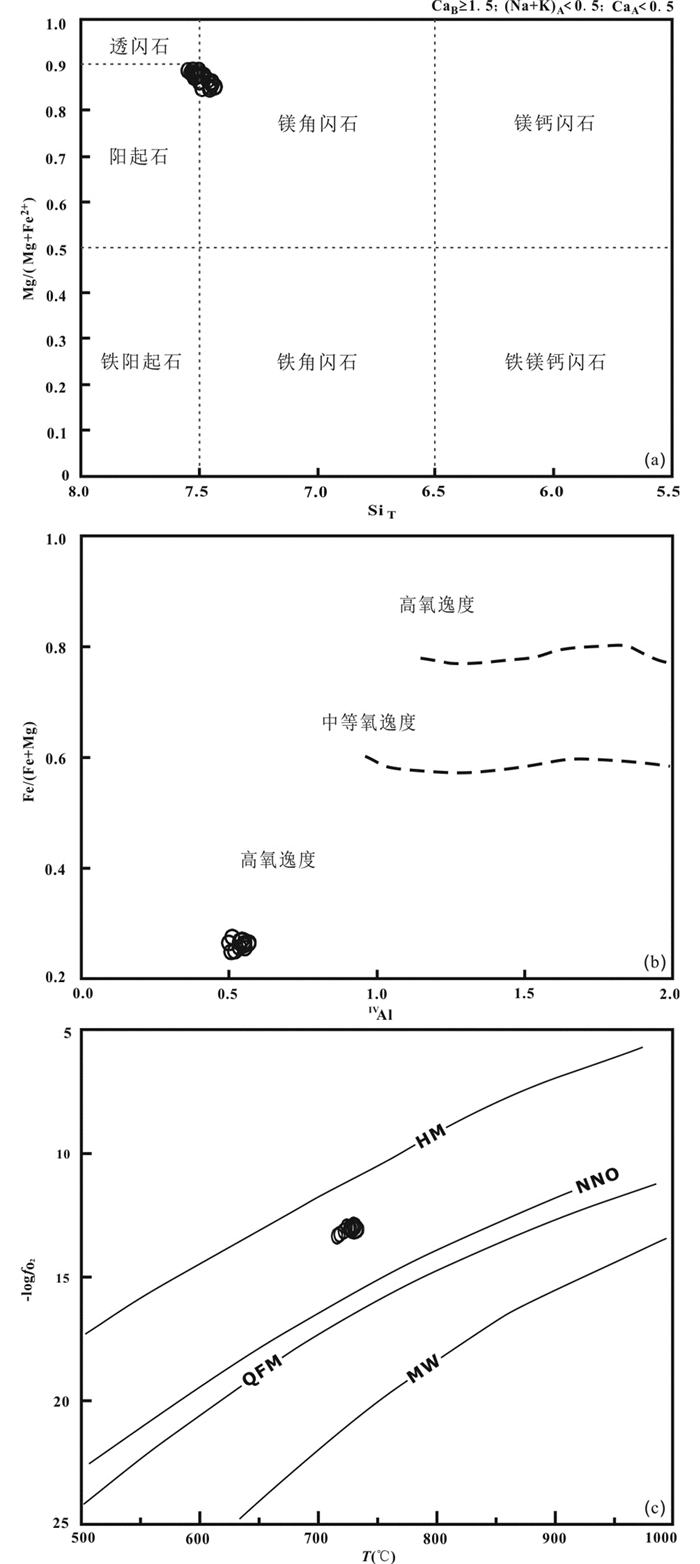
|
图 9 努尔卡斯甘富金斑岩铜矿石英闪长岩中角闪石特征 (a)角闪石分类图解(Leake et al., 1997);(b)镁角闪石Fe/(Fe+Mg) -IVAl图解(Anderson and Smith, 1995);(c)氧逸度-温度图解,HM:赤铁矿-磁铁矿; NNO:镍-氧化镍; QFM:石英-铁橄榄石-磁铁矿; MW:磁铁矿-方铁矿(Chou,1987) Fig. 9 Characteristics of hornblendes in quartz diorite from the Nurkazgan gold-rich porphyry copper deposit (a) classification of hornblendes (Leake et al., 1997); (b) hornblendes Fe/(Fe+Mg) vs. IVAl diagrams (Anderson and Smith, 1995); (c) oxygen fugacity and temperature diagram, HM: hematite-magnetite; NNO: nickel-nickel oxide; QFM: quartz-fayalite-magnetite; MW:magnetite-wustite (Chou, 1987) |
实验岩石学研究证实,温度恒定条件下,岩浆岩中镁铁质硅酸盐矿物的Fe/(Fe+Mg)比值是岩浆氧逸度的函数(Prouteau and Scaillet, 2003)。石英闪长岩中的镁角闪石的Fe/(Fe+Mg)比值低,暗示岩浆具有高氧化性特征(图 9b)。根据Ridolfi et al.(2010)推荐的经验性公式,利用镁角闪石成分,可以计算角闪石结晶温度和相应岩浆氧逸度。因此,我们利用角闪石的化学成分对角闪石结晶温度和石英闪长岩的氧逸度进行了计算。但为了尽可能避免热液蚀变对石英闪长岩岩浆氧逸度计算的影响,我们选择利用镁角闪石而避免采用阳起石化角闪石的成分。通过Ridolfi et al.(2010)推荐的经验性公式计算,获得角闪石结晶温度范围为713~732℃,岩浆氧逸度:fO2为-13.37~-12.92(平均-13.06),相应△NNO值为+2.36~+2.69(均值+2.5)(表 3)。在-logfO2-T(℃)图解中,数据点都处于赤铁矿-磁铁矿缓冲线(HM)和镍-氧化镍缓冲线(NNO)之间(图 9c),也显示石英闪长岩浆具有较高氧逸度。而且,这一计算结果还与在石英闪长岩中观察到的石英+磁铁矿+榍石组合(图 10)所指示的高岩浆氧逸度(>△NNO+2;Dilles,1987;Wones,1989)较为吻合。因此,由镁角闪石成分推算所得石英闪长岩岩浆氧逸度较为合理,大致为△NNO+2.5,氧化状态较高。
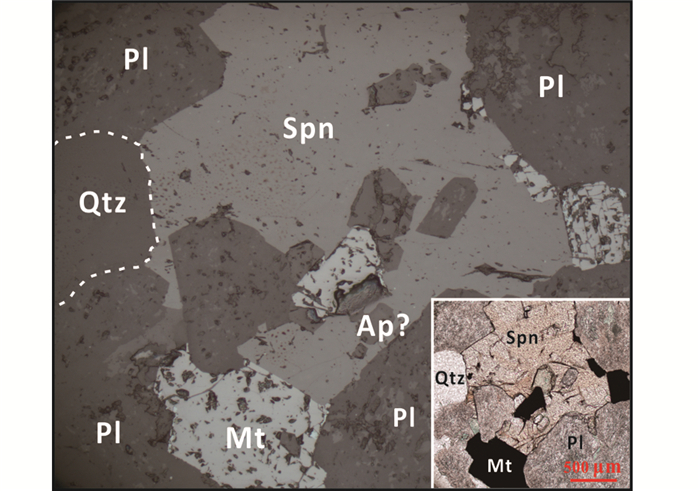
|
图 10 努尔卡斯甘富金斑岩铜矿石英闪长岩中石英-磁铁矿-榍石矿物组合显微照片(反射光,12HS04-10) 右下角内图为其单偏光显微照片.Spn-榍石 Fig. 10 Photomicrographs of quartz-magnetite-sphene assemblage in quartz diorite showing magma with high oxygen fugacity (12HS04-10; reflected light) The small picture at the right bottom underPPL. Abbreviations: Spn-sphene |
通过扫描电镜观察(图 11)和能谱分析(图 12),我们在2件钾钙硅酸盐化样品(已叠加较弱绿泥石化、绢云母化和伊利石化蚀变)、4件中级泥化样品和1件热液角砾岩样品中发现了独立金矿物存在,以自然金为主(图 11a-i),少量银金矿(图 11j,k)。其中,自然金均赋存在蚀变岩矿石中,而银金矿基本上分布在热液角砾岩矿石的黄铜矿胶结物中,蚀变岩矿石中仅偶见其与自然金伴生。在其他富金斑岩型铜矿床中,自然金常作为包裹体寄存在斑铜矿、黄铜矿、黄铁矿和石英中或紧贴硫化边部生长(如Batu Hijau铜金矿,Arif and Baker, 2004)。然而,斑铜矿、黄铜矿、黄铁矿和石英的重点侦测结果显示,努尔卡斯矿床中斑铜矿、黄铜矿和黄铁矿空间上罕见伴生独立自然金产出,石英中的自然金包裹体也较为少见,而其中的硅酸盐矿物与自然金关系密切。
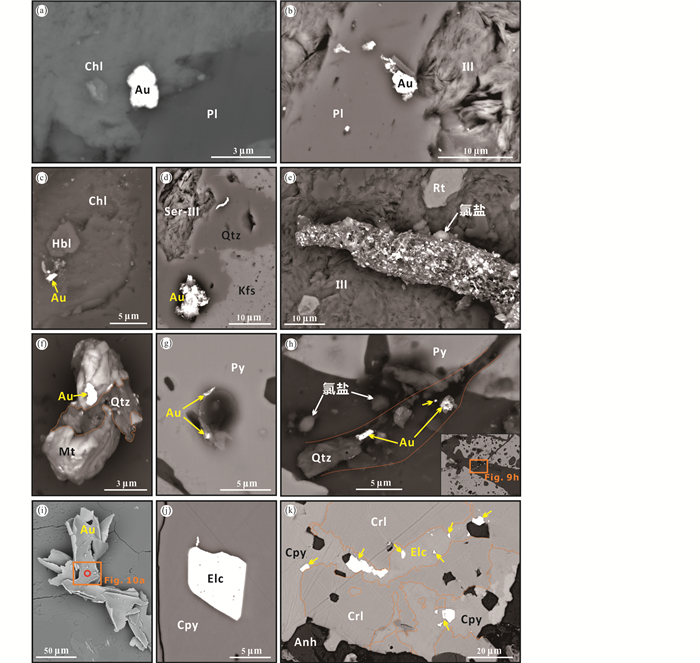
|
图 11 努尔卡斯甘富金斑岩型铜矿床自然金和银金矿背散射(SEM-BSE)照片 (a)自然金分布在斜长石蚀变前缘与绿泥石共生(12HS02-9);(b)自然金分布在斜长石蚀变前缘与伊利石共生(12HS05-4);(c)自然金赋存于角闪石的蚀变产物——绿泥石之中(12HS04-12);(d)自然金被石英包裹在微裂隙旁边(12HS05-4);(e)自然赋存于由硅酸盐矿物组成的管状体上(12HS02-11);(f)自然金赋存于磁铁矿和石英颗粒之间(12HS04-12);(g)自然金被包裹于黄铁矿中(12HS01-3);(h)自然金与石英沿穿切黄铁矿的微裂隙分布(12HS01-3);(i)叶片状自然金和图 10a中能谱分析点位——红色圆圈(12HS03-4);(j)与中级泥化相关热液角砾岩黄铜矿胶结物中包裹的银金矿(12HS04-13);(k)与中级泥化相关热液角砾岩中,黄铜矿交代硫钴铜矿,其中包裹由银金矿和硬石膏(12HS04-13). Au-自然金;Crl-硫钴铜矿;Elc-银金矿 Fig. 11 The SEM-BSE images of native gold and electrum from Nurkazgan gold-rich porphyry copper deposit (a) native gold occurs at the margins of chloritized hornblende (12HS02-9);(b) native gold occurs at the margins of illitized plagioclase (12HS05-4);(c) native gold is within the chlorite which has partly replaced hornblende (12HS04-12);(d) native gold is enclosed in quartz and nearby a microfracture which has been cut through the quartz (12HS05-4);(e) native gold occurs on a pipe consisting of silicate minerals (12HS02-11);(f) native gold occurs between magnetite grain and quart (12HS04-12);(g) native gold within pyrite (12HS01-3);(h) native gold and some quartz has filled in a microfracture cutting through pyrite (12HS01-3);(i) native gold leaf and the location of analysis point of EDS represented by red circle in Fig. 10a (12HS03-4);(j) a electrum grain encapsulated in chalcopyrite cement from hydrothermal breccias associated with intermediate argillic alteration (12HS04-13);(k) several electrum and anhydrite grains occur in chalcopyrite cement which has partly replaced carrollite (12HS04-13). Abbreviations: Au-native gold; Crl-carrollite; Elc-electrum |
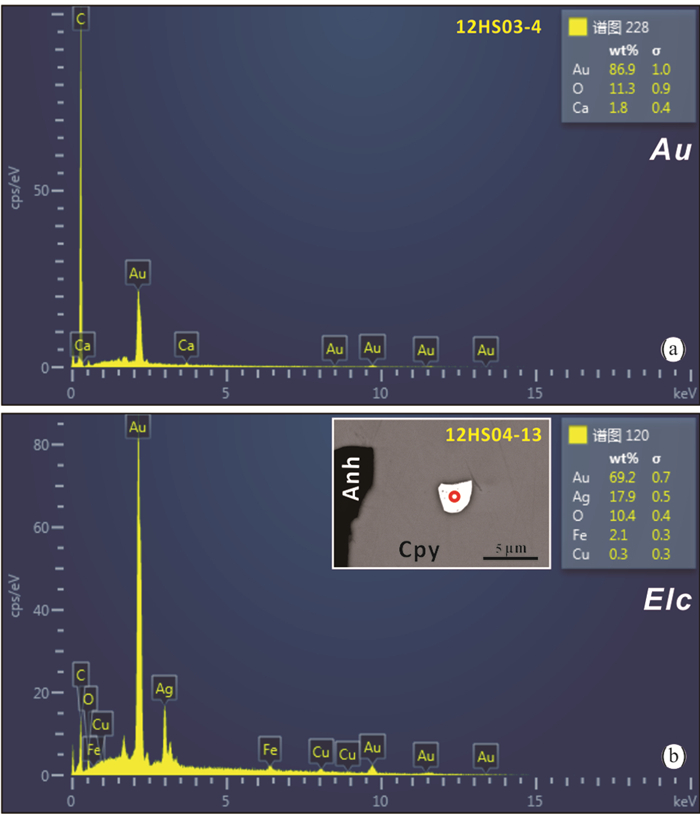
|
图 12 努尔卡斯甘富金斑岩型铜矿床典型自然金(a)和银金矿(b,其内背散射图像中红色圆圈代表相应分析点位)能谱图 Fig. 12 Typical EDS spectra of native gold (a) and electrum (b, red circle within inner SEM-BSE image represents the location of analysis point of EDS) in Nurkazgan gold-rich porphyry copper deposit |
自然金绝大多数呈不规则粒状(图 11a-h),有时可见叶片状(图 11i)。粒状自然金粒径变化大,小至亚显微状(<1μm),大可达25μm,但绝大多数不超过10μm(图 13)。叶片状自然金粒径较大,最大可达200μm,极大的金叶片自边缘向内可显示出一定卷曲变形(图 11i)。银金矿形态分规则粒状和不规则状粒状两种,粒径<1~20μm,多集中于2~8μm(图 11j,k)。

|
图 13 努尔卡斯甘富金斑岩铜矿床中与不同热液蚀变阶段相关的自然金粒度直方图 Fig. 13 Histograms showing the grain sizes of native gold associtated with potassic-calcic silicate and intermediate argillic alteration in Nurkazgan gold-rich porphyry copper deposit |
金矿物在矿石中的形态及其与其他矿物之间的接触关系,即金矿物的按嵌布类型主要为粒间金、吸附金和包裹金,极少量裂隙金(图 13)。不同嵌布类型的金矿物特征如下:
① 粒间金:分布在中级泥化和钾钙硅酸盐化蚀变岩中,均为自然金,粒径多为1~6μm,最大可达25μm(图 13),常分布在斜长石与伊利石、绿泥石(图 11a,b)或角闪石与绿泥石(图 11c)、绿泥石(其间可见黑云母残余)与石英等矿物晶粒接触边界,即位于斜长石、角闪石和黑云母等原生造岩矿物的蚀变前缘。因此,即使在钾钙硅酸盐化蚀变岩中,粒间金的沉淀也与绿泥石化、绢云母化和伊利石化等蚀变叠加作用密切相关,而并非钾钙硅酸盐化蚀变,暗示粒间金沉淀主要发生在中级泥化蚀变过程中。
② 吸附金:主要分布于中级泥化蚀变岩中,均为自然金,主要为亚显微状(<1μm),也有些大粒径颗粒(~12μm,图 13),通常以成簇的形式赋存在细粒石英、硬石膏和硅酸盐矿物表面(图 11e),其中亚显微状自然金往往散落在大颗粒自然金周围。矿物表面分布金粒常见于硫化物矿物,如黄铁矿(吴忠伟等,2011),国外学者认为这与硫化物表面的吸附作用有密切联系(Bancroft and Jean, 1982;Jean and Michael Bancroft,1985;Bancroft and Hyland, 1990;Mycroft et al., 1995;Widler and Seward, 2002),是造成金的沉淀机制之一(Redmond,2002)。鉴于此,我们初步推测努尔卡斯甘这类矿物表面的亚显微金粒也可能与吸附作用有关,并为了方便描述,将其统一命名为“吸附金”。同时,推测矿物表面观察到的大颗粒金可能是水-岩过程,矿物表面吸附新亚显微金粒而不断生长的结果。
③ 包裹金:主要为银金矿,少量自然金。银金矿以矿物包裹体的形式赋存在热液角砾岩的黄铜矿胶结物中,与黄铜矿和硬石膏的沉淀关系密切(图 11j,k),而且,其中的胶结物还富含绿泥石和板状磁铁矿(图 5e),均与黄铜矿紧密伴生。自然金包裹体较少,在含金的钾钙硅酸盐化石英闪长岩中,2个石英晶体中包裹有自然金,其一与热液钾长石共生,包含2粒自然金和磁铁矿晶粒,而另一石英与热液钾长石、绢云母-伊利石共生,其内包裹1粒自然金和若干细粒钾长石(图 11d)。这些矿物组合特点表明,前者中的包裹金很可能与钾硅酸盐化蚀变有关,金沉淀发生在硅化和钾长石化过程中,而后者中的包裹金与后期叠加的长石破坏蚀变有关,自然金沉淀发生于钾长石遭受绢云母-伊利石化蚀变,并析出石英的过程中。在中级泥化蚀变岩中,极少自然金呈亚显微状被包裹于黄铁矿中(图 11g)。
④ 裂隙金:极少,均为自然金,在中泥化蚀变岩中细粒自然金与石英充填穿切黄铁矿的微裂隙(图 11h、图 13)。
综上所述,努尔卡斯甘铜金矿床中发育独立金矿物,主要为自然金和少量银金矿,呈粒间金、吸附金、包裹金和裂隙金等形式赋存。而且,金矿化基本上都与中级泥化蚀变密切相关,这与前人研究中富矿体位于绿泥石化-绢云母化-碳酸盐化(中级泥化)与钾长石化-黑云母化(钾化)叠加部位(Zhukov et al., 1997)较为吻合。而且,Seltmann et al.(2014)也指出金矿化与泥化蚀变(绿泥石-伊利石-碳酸盐-石英)关系密切。但是,我们也发现有极少数石英中的包裹金(2粒)沉淀与钾钙硅酸盐化蚀变有关(图 13)。因此,努尔卡斯甘铜金矿床金沉淀主要与中级泥化蚀变有关(1g/t Au,Seltmann et al., 2014),但早期钾钙硅酸盐化阶段也发育少量金矿化。
8 讨论 8.1 高氧化-高硫岩浆-热液成矿体系及其对努尔卡斯甘铜金成矿作用的制约努尔卡斯甘斑岩铜金矿床早期钾钙硅酸盐化带中发育热液磁铁矿和热液硬石膏,指示母岩浆为高氧化岩浆,这与努尔卡斯甘矿床含矿岩体普遍都显示出了高氧化性相符。根据全岩Fe3+/Fe2+比值,花岗闪长斑岩、石英闪长玢岩和闪长岩岩浆都处于高氧化状态(图 14)。其中,石英闪长玢岩氧逸度高,接近于赤铁矿-磁铁矿缓冲线(HM)(Shen et al., 2015)。此外,角闪石氧逸度计和石英-磁铁矿-榍石矿物组合综合表明,石英闪长岩岩浆氧逸度大致为ΔNNO+2.5,也显示出高氧化性特征。因此,努尔卡斯甘矿区普遍发育高氧化岩浆系统。同时,这些热液磁铁矿和热液硬石膏的大量出现,还说明成矿热液继承了母岩浆的高氧化性特征(Richards,2015)。与西藏驱龙巨型斑岩铜钼矿床相似,努尔卡斯甘矿床的热液硬石膏也基本上贯穿整个热液成矿过程,呈热液脉、角砾胶结物和浸染状出现在钾钙硅酸盐化、中级泥化和绢云母化阶段。它们作为热液活动的直接产物,指示高氧化成矿热液含有较高硫含量且硫具有较高氧化状态,主要为SO2和HSO4-(SO42-)(Binder and Keppler, 2011)。据Kolesnikov(1991)研究资料,中哈萨克斯坦地区斑岩铜矿的S为深部岩浆来源(李光明等,2008)。而且,努尔卡斯甘斑岩铜金矿床矿区地层为Zhasor组火山岩、凝灰岩和浊积岩,并不发育膏盐层。因此,其高氧化成矿岩浆热液的高硫含量也应继承自母岩浆,这说明成矿岩浆是富硫的。综上,我们认为努尔卡斯甘富金斑岩铜矿发育与西藏驱龙巨型斑岩铜钼矿相似的高氧化-高硫岩浆-热液成矿体系(肖波等,2009;肖波,2011;赵俊兴,2017)。

|
图 14 努尔卡斯甘富金斑岩铜矿床含矿岩体全岩Lg(Fe2O3/FeO)-FeOT图解 数据源自Shen et al., 2016;氧化还原状态界线据Blevin, 2004, 其中中等还原区域与中等氧化区域之间的界线(粗实线)与FMQ缓冲线相近 Fig. 14 Lg(Fe2O3/FeO) vs. FeOT for ore-host plutonic rocks in Nuerkazgan gold-rich porphyry copper deposit Data from Shen et al., 2016; Relative oxidation state boundaries are from Blevin, 2004, in which the thick black line between the "moderately reduced" and "moderately oxidized" fields approximates the FMQ buffer curve |
成矿岩浆富水、富硫、高氧化性是控制斑岩型Cu (±Au±Mo)矿床成矿三大关键因素(孙卫东等,2015;Seo et al., 2009;Botcharnikov et al., 2011, 2013;Sillitoe,2000;Richards, 2011a, b ,2015;Wang et al., 2014a, b ;Sun et al., 2013, 2015)。高氧化性岩浆很大程度上影响着斑岩型Cu(±Au±Mo)的形成,例如,Lu et al.(2016)和Dilles et al.(2015)对成矿斑岩和不成矿斑岩中锆石系统研究表明,成矿斑岩氧逸度明显比不成矿斑岩高。铜、金和钼属于亲铜元素,其地球化学行为受硫化物相强烈控制(Sun et al., 2015)。然而,在高氧化状态下,不利于地幔源区残留硫化物相稳定存在(Chiaradia,2014)。因此,高氧化性地幔源区发生较低程度部分熔融便可以完全熔出其中的硫化物(Jugo,2009),形成高氧化、富金属的原始成矿岩浆(Mungall,2002;Lee et al., 2012)。其中,富金原始成矿岩浆形成可能与地幔楔异常高氧化状态而造成源区残留硫化物极少有关(Richards,2011b)。实验岩石学研究表明,岩浆中硫酸盐溶解度远大于硫化物(Beermann et al., 2011;Jugo,2009)。岩浆氧逸度一旦高于ΔFMQ+1,其中的溶解硫便由硫化物(S2-)为主转变成以硫酸盐(S6+)为主(Jugo et al., 2005, 2010;Richards,2015),造成岩浆中硫化物相难以发生饱和,铜、金和钼等金属在岩浆演化早期发生富集(Richards,2015;Sun et al., 2015)。同时,还造成岩浆中溶解硫含量大量增加,从而满足后期热液成矿阶段金属硫化物沉淀对硫的巨量需求。因此,努尔卡斯甘高氧化含矿岩浆无疑可强有力地从地幔源区向浅部地壳运移大量铜、金和硫(硫酸盐)。Shen et al.(2015)在对中亚成矿域11个不同规模斑岩铜矿的成矿斑岩锆石Ce4+/Ce3+研究中发现,这些矿床的规模大小与岩浆氧逸度密切相关,大型矿床努尔卡斯甘和波谢库尔等成矿岩浆往往显示出高氧化状态(ΔNNO+4.5~ΔNNO+4.8),说明高氧化岩浆对努尔卡斯甘铜金成矿具有重要控制作用。
高氧化、富金属和硫的母岩浆达到水饱和发生高氧化、高硫岩浆流体出溶时,由于磁铁矿结晶,岩浆中的硫酸根(SO42-)被还原形成大量HS-(可能还有S3-)进入到岩浆热液中(孙卫东等,2015;Sun et al., 2004, 2013, 2015),又可有效地提高努尔卡斯甘高氧化-高硫成矿热液萃取、溶解和搬运铜和金的能力(Loucks and Mavrogenes, 1999;Simon et al., 2006;Seo et al., 2009;Zajacz et al., 2010;Frank et al., 2011;Simon and Ripley, 2011)。最近一些实验研究显示(Pokrovski and Dubrovinsky, 2011;Pokrovski and Dubessy, 2015;Pokrovski et al., 2015),较宽温压条件范围内(200~700℃,~30kbar),热液流体中可稳定存在S3-,在300~500℃弧相关岩浆热液中其含量可占到溶解硫总量的10%。S3-对岩浆热液萃取和搬运Au意义重大,因为流体中Au与S3-可在高温高压条件(>350℃,500bar)下强烈络合(Au(HS)S3-)而发生大量溶解(Pokrovski et al., 2015)。然而,流体中硫含量会强烈影响Au(HS)S3-的稳定性,高硫含量明显更利于Au与S3-大量络合(Pokrovski et al., 2015)。因此,努尔卡斯甘矿床的高氧化、高硫成矿热液对金的大量萃取和搬运意义重大。
8.2 金沉淀机制初探热液成矿过程中,金属元素快速从成矿流体沉淀析出是由于热液物理化学条件的变化,引起这一变化的因素较多,比如温度、压力和氧逸度变化、流体混合、流体沸腾、水-岩相互作用等(Hedenquist et al., 1998;Hezarkhani et al., 1999)。基于矿化特征、热液蚀变、热液脉系、矿物共生顺序及金赋存状态等方面的细致研究,我们尝试对努尔卡斯甘富金斑岩型铜矿床金沉淀机理做出一些初步约束。
上已述及,努尔卡斯甘铜金矿床金矿化主要发生在中泥化蚀变阶段,而且,该阶段还发育富铜矿化(>1%~1.5% Cu、1g/t Au,Seltmann et al., 2014)。我们的研究表明,在中级泥化阶段:①硬石膏化强烈,呈浸染状、多种细脉和角砾胶结物形式产出,与磁铁矿(图 5b, e)和黄铜矿(图 4g、图 5e、图 7g、图 11k)关系密切;②发育磁铁矿,多与黄铜矿共生或被其包裹(图 5d-f);③绿泥石与黄铜矿矿化关系密切(图 6f、图 7g);④自然金常赋存在蚀变岩中斜长石、角闪石和黑云母蚀变前缘,与绿泥石和伊利石伴生(图 11a-d)。综合这些现象,我们推断金的沉淀可能与水-岩作用过程中硬石膏和磁铁矿析出有密切联系。
通常,中级泥化蚀变形成温度通常较低(<400℃,Seedorff et al., 2005),比如菲律宾Far Southeast矿床中,同样与主要金矿化相关的中级泥化蚀变温度大致为350℃(绢云母-伊利石-绿泥石化)(Hedenquist et al., 1998),利于高氧化-高硫成矿热液中SO2发生歧化反应(<400℃)(方程式1,Richards, 2011a, b ;Kouzmanov and Pokrovski, 2012),产生还原硫和H+,降低流体的pH。而且,磁铁矿结晶促使流体中的SO42-被还原释放S2-和H+,并造成流体氧逸度升高(出现赤铁矿)(方程式2,Liang et al., 2009;Sun et al., 2015)。在酸性环境下,黑云母和角闪石和斜长石发生蚀变释放Fe2+和Ca2+(方程式3、4、5和6),其中Ca2+与SO42-结合形成硬石膏(方程式7),促进SO2歧化反应的进行。同时,由于还原S含量增加,流体中的Cu2+和(或)Fe2+,以及水-岩作用释放的Fe2+与之结合致使黄铁矿和黄铜矿发生沉淀(方程式8和9),从而造成黄铜矿与磁铁矿、硬石膏和绿泥石相互伴生以及形成石英-绿泥石-硬石膏-黄铜矿脉(图 7g)、硬石膏-黄铜矿-黄铁矿脉(图 7d)和富硬石膏±绿泥石的矿化热液角砾岩(图 4g)等。与此同时或稍后,金矿物由于pH显著降低(Au(HS)S3-分解)以及大量黄铜矿、黄铁矿等晶出带走其二硫化物配体(Au(HS)2-分解)或流体中总硫减少(Au(HS)S3-分解)而发生沉淀(Richards,2011b;Pokrovski et al., 2015),从而可见其充填在黄铁矿微裂隙(图 11g,h)和包裹在黄铜矿中(图 11j,k)。因此,SO2发生歧化反应以及磁铁矿和硬石膏的结晶造成高氧化-高硫成矿流体的SO42-/H2S比值和pH显著降低可能是诱发中级泥化带中金发生沉淀重要因素。钾钙硅酸盐化阶段也发育磁铁矿和硬石膏化,而金矿化微弱,可能与此时流体温度较高(>400℃)和pH较大(偏碱性,Au(HS)2-较稳定)有关。

|
(1) |

|
(2) |

|
(3) |

|
(4) |

|
(5) |

|
(6) |

|
(7) |

|
(8) |

|
(9) |
努尔卡斯甘富金斑岩铜矿床垂向上自下而上发育钾化带、中级泥化带和绢云母化带(Zhukov et al., 1997;李光明等,2008),相应硫化物组成依次为斑铜矿-黄铜矿、黄铜矿-黄铁矿±蓝辉铜矿、黄铁矿±黄铜矿(图 8),这一热液蚀变、矿化组合以及相应分带特征与世界上其他中-新生代富金斑岩型铜矿床相似(Sillitoe,2000;李金祥等,2006)。但与多数斑岩铜成矿系统相比,如North Parkes(Heithersay and Walshe, 1995)、Grasberg(Pollard and Taylor, 2002)、Rekodiq(Perelló et al., 2008)、Bingham(Keith et al., 1997)、西藏多不杂(李光明等,2007)和荣那(李光明等,2015)等,努尔卡斯甘铜金矿床一大特色表现为热液硬石膏丰富,其基本上贯穿整个热液成矿过程,呈多种形式产于各蚀变带中,指示其发育其他矿床较为少见的高氧化-高硫岩浆热液体系。
就金与热液蚀变之间的关系而言,努尔卡斯甘斑岩型铜金矿床的差异性特征较为明显。努尔卡斯甘矿床中,金矿化主要和中级泥化蚀变密切相关,与菲律宾Far Southeast、巴基斯坦Rekodiq矿集区H8和蒙古国Oyu Tolgoi等个别矿床较为相似(Hedenquist et al., 1998;Khashgerel et al., 2006;Perelló et al., 2008)。而且,除少数银金矿被包裹在黄铜矿胶结物中以外,绝大多数金矿物与硫化关系不大,而与绿泥石或伊利石伴生或吸附在其他硅酸盐矿物表面。然而,世界上绝大多数富金斑岩型铜矿金矿化主要赋存在钾硅酸盐化带,与早期钾化阶段A型石英脉关系密切,金常呈细粒自然金与石英、黄铜矿和斑铜矿伴生或被其包裹、吸附(Redmond,2002),如Bingham(Redmond,2002;Redmond and Einaudi, 2010)、Bajo de la Alumbrera(Ulrich and Heinrich, 2002)和Batu Hijau(Arif and Baker, 2004)等富金斑岩型铜矿。
9 结论(1) 努尔卡斯甘富金斑岩型铜矿与花岗闪长斑岩和石英闪长玢岩侵位有关,发育浸染状、网脉状和热液角砾岩型矿化。铜金矿化产于花岗闪长斑岩、石英闪长玢岩、石英闪长岩和少量闪长岩中,部分也赋存于岩体外接触带火山岩地层中。
(2) 矿床热液蚀变强烈,发育阳起石化、钠长石化、钾长石化、黑云母化、硬石膏化、绿泥石化、伊利石化、绢云母化、硅化、碳酸盐化、绿帘石化及磁铁矿化。与世界绝大多数富金斑岩铜矿不同,努尔卡斯甘矿床金矿化主要与中级泥化蚀变密切相关,而非钾硅酸盐化。
(3) 金属硫化物显示出较好分带性,钾化带为斑铜矿-黄铜矿组合,中级泥化带为黄铜矿-黄铁矿±蓝辉铜矿组合,绢云母化带为黄铁矿±黄铜矿组合。
(4) 金赋存状态主要为细粒自然金和银金矿,其中自然金主要呈粒间金、吸附金和包裹金以及少量裂隙金的形式赋存在蚀变岩中,而银金矿主要呈包裹金的形式分布热液角砾岩的黄铜矿胶结物中。
(5) 矿床属于高氧化-高硫岩浆-热液成矿体系。在中级泥化蚀变过程中,SO2歧化反应以及磁铁矿和硬石膏大量结晶造成的高氧化-高硫成矿热液的SO42-/H2S比值和pH显著降低很可能是诱发金发生大规模沉淀的重要因素。
致谢 金矿物扫描电镜研究得到了中国科学院地质与地球物理研究所电子探针与扫描电镜实验室闫欣高级工程师和杨赛红工程师悉心指导和帮助;李昌昊博士协助完成了电子探针分析工作;两位审稿人提出了宝贵的审稿意见;在此谨致谢忱!
Abdulin AA, Bespaev HA, Votsalevsky ES, Daukeev SZH and Miroshnichenko LA. 1996. Map of Mineral Resources of Kazakstan: Non-ferrous Metals, Scale 1: 2000000. Alma-Ata: IPC
|
Anderson JL and Smith DR. 1995. The effects of temperature and fO2 on the Al-in-hornblende barometer. American Mineralogist, 80(5-6): 549-559. DOI:10.2138/am-1995-5-614 |
Arancibia ON and Clark AH. 1996. Early magnetite-amphibole-plagioclase alteration-mineralization in the Island copper porphyry copper-gold-molybdenum deposit, British Columbia. Economic Geology, 91(2): 402-438. DOI:10.2113/gsecongeo.91.2.402 |
Arif J and Baker T. 2004. Gold paragenesis and chemistry at Batu Hijau, Indoneisa:Implications for gold-rich porphyry copper deposits. Mineralium Deposita, 39(5-6): 523-535. DOI:10.1007/s00126-004-0433-0 |
Bancroft GM and Jean G. 1982. Gold deposition at low temperature on sulphide minerals. Nature, 298(5876): 730-731. DOI:10.1038/298730a0 |
Bancroft GM and Hyland MM. 1990. Spectroscopic studies of adsorption/reduction reactions of aqueous metal complexes on sulphide surfaces. Reviews in Mineralogy and Geochemistry, 23(1): 511-558. |
Beermann O, Botcharnikov RE, Holtz F, Diedrich O and Nowak M. 2011. Temperature dependence of sulfide and sulfate solubility in olivine-saturated basaltic magmas. Geochimica et Cosmochimica Acta, 75(23): 7612-7631. DOI:10.1016/j.gca.2011.09.024 |
Binder B and Keppler H. 2011. The oxidation state of sulfur in magmatic fluids. Earth and Planetary Science Letters, 301(1-2): 190-198. DOI:10.1016/j.epsl.2010.10.042 |
Blevin PL. 2004. Redox and compositional parameters for interpreting the granitoid metallogeny of eastern Australia:Implications for gold-rich ore systems. Resource Geology, 54(3): 241-252. DOI:10.1111/rge.2004.54.issue-3 |
Botcharnikov RE, Linnen RL, Wilke M, Holtz F, Jugo PJ and Berndt J. 2011. High gold concentrations in sulphide-bearing magma under oxidizing conditions. Nature Geoscience, 4(2): 112-115. DOI:10.1038/ngeo1042 |
Botcharnikov RE, Holtz F, Mungall JE, Beermann O, Linnen RL and Garbe-Schönberg D. 2013. Behavior of gold in a magma at sulfide-sulfate transition:Revisited. American Mineralogist, 98(8-9): 1459-1464. DOI:10.2138/am.2013.4502 |
Chiaradia M. 2014. Copper enrichment in arc magmas controlled by overriding plate thickness. Nature Geoscience, 7(1): 43-46. DOI:10.1038/ngeo2028 |
Chou IM. 1987. Oxygen buffer and hydrogen sensor techniques at elevated pressures and temperatures. In: Ulmer GC and Barnes HL (eds. ). Hydrothermal Experimental Techniques. Chichester: John Wiley, 61-99
|
Dilles JH. 1987. Petrology of the Yerington batholith, Nevada:Evidence for evolution of porphyry copper ore fluids. Economic Geology, 82(7): 1750-1789. DOI:10.2113/gsecongeo.82.7.1750 |
Dilles JH and Einaudi MT. 1992. Wall-rock alteration and hydrothermal flow paths about the Ann-Mason porphyry copper deposit, Nevada:A 6km vertical reconstruction. Economic Geology, 87(8): 1963-2001. DOI:10.2113/gsecongeo.87.8.1963 |
Dilles JH, Kent AJR, Wooden JL, Tosdal RM, Koleszar A, Lee RG and Farmer LP. 2015. Zircon compositional evidence for sulfur-degassing from ore-forming arc magmas. Economic Geology, 110(1): 241-251. DOI:10.2113/econgeo.110.1.241 |
Frank MR, Simon AC, Pettke T, Candela PA and Piccoli PM. 2011. Gold and copper partitioning in magmatic-hydrothermal systems at 800℃and 100MPa. Geochimica et Cosmochimica Acta, 75(9): 2470-2482. DOI:10.1016/j.gca.2011.02.012 |
Gustafson LB and Hunt JP. 1975. The porphyry copper deposit at El Salvador, Chile. Economic Geology, 70(5): 857-912. DOI:10.2113/gsecongeo.70.5.857 |
Hedenquist JW, Arribas A and Reynolds TJ. 1998. Evolution of an intrusion-centered hydrothermal system:Far Southeast-Lepanto porphyry and epithermal Cu-Au deposits, Philippines. Economic Geology, 93(4): 373-404. DOI:10.2113/gsecongeo.93.4.373 |
Heinhorst J, Lehmann B, Ermolov P, Serykh V and Zhurutin S. 2000. Paleozoic crustal growth and metallogeny of Central Asia:Evidence from magmatic-hydrothermal ore systems of Central Kazakhstan. Tectonophysics, 328(1-2): 69-87. DOI:10.1016/S0040-1951(00)00178-5 |
Heithersay PS and Walshe JL. 1995. Endeavour 26 North:A porphyry copper-gold deposit in the Late Ordovician, shoshonitic Goonumbla volcanic complex, New South Wales, Australia. Economic Geology, 90(6): 1506-1532. DOI:10.2113/gsecongeo.90.6.1506 |
Hezarkhani A, Williams-Jones AE and Gammons CH. 1999. Factors controlling copper solubility and chalcopyrite deposition in the Sungun porphyry copper deposit, Iran. Mineralium Deposita, 34(8): 770-783. DOI:10.1007/s001260050237 |
Jean GE and Michael Bancroft G. 1985. An XPS and SEM study of gold deposition at low temperatures on sulphide mineral surfaces:Concentration of gold by adsorption/reduction. Geochimica et Cosmochimica Acta, 49(4): 979-987. DOI:10.1016/0016-7037(85)90312-6 |
Jugo PJ, Luth RW and Richards JP. 2005. Experimental data on the speciation of sulfur as a function of oxygen fugacity in basaltic melts. Geochimica et Cosmochimica Acta, 69(2): 497-503. DOI:10.1016/j.gca.2004.07.011 |
Jugo PJ. 2009. Sulfur content at sulfide saturation in oxidized magmas. Geology, 37(5): 415-418. DOI:10.1130/G25527A.1 |
Jugo PJ, Wilke M and Botcharnikov RE. 2010. Sulfur K-edge XANES analysis of natural and synthetic basaltic glasses:Implications for S speciation and S content as function of oxygen fugacity. Geochimica et Cosmochimica Acta, 74(20): 5926-5938. DOI:10.1016/j.gca.2010.07.022 |
Keith JD, Whitney JA, Hattori K, Ballantyne GH, Christiansen EH, Barr DL, Cannan TM and Hook CJ. 1997. The role of magmatic sulfides and mafic alkaline magmas in the Bingham and Tintic mining districts, Utah. Journal of Petrology, 38(12): 1679-1690. DOI:10.1093/petroj/38.12.1679 |
Khashgerel BE, Rye RO, Hedenquist JW and Kavalieris I. 2006. Geology and reconnaissance stable isotope study of the Oyu Tolgoi porphyry Cu-Au system, South Gobi, Mongolia. Economic Geology, 101(3): 503-522. DOI:10.2113/gsecongeo.101.3.503 |
Kolesnikov VV. 1991. Nonferrous Matals Deposits. Alma-Ata:Gylym: 192. |
Kouzmanov K and Pokrovski GS. 2012. Hydrothermal controls on metal distribution in porphyry Cu (-Mo-Au) systems. In: Hedenquist JW, Harris M and Camus F (eds. ). Geology and Genesis of Major Copper Deposits and Districts of the World: A Tribute to Richard H. Littleton: Society of Economic Geologists, Inc., Special Publication, 16(22): 573-618
|
Leake BE, Woolley AR, Arps CES, Birch WD, Gilbert MC and Grice JD. 1997. Nomenclature of amphiboles:Report of the Subcommittee on Amphiboles of the International Mineralogical Association Commission on New Ninerals and Nineral Names. Mineralogical Magazine, 61(2): 295-321. |
Lee CTA, Luffi P, Chin EJ, Bouchet R, Dasgupta R, Morton DM, Le Roux V, Yin ZQ and Jin D. 2012. Copper systematics in arc magmas and implications for crust-mantle differentiation. Science, 336(6077): 64-68. DOI:10.1126/science.1217313 |
Li GM, Li JX, Qin KZ, Zhang TP and Xiao B. 2007. High temperature, salinity and strong oxidation ore-forming fluid at Duobuza gold-rich porphyry copper deposit in the Bangonghu tectonic belt, Tibet:Evidence from fluid inclusions. Acta Petrologica Sinica, 23(5): 935-952. |
Li GM, Qin KZ and Li JX. 2008. Geological features and tectonic setting of porphyry copper deposits rounding the Balkhash region, Central Kazakhstan, Central Asia. Acta Petrologica Sinica, 24(12): 2679-2700. |
Li GM, Zhang XN, Qin KZ, Sun XG, Zhao JX, Yin XB, Li JX and Yuan HS. 2015. The telescoped porphyry-high sulfidation epithermal Cu(-Au) mineralization of Rongna deposit in Duolong ore cluster at the southern margin of Qiangtang Terane, Central Tibet:Integrated evidence from geology, hydrothermal alteration and sulfide assemblages. Acta Petrologica Sinica, 31(8): 2307-2324. |
Li JX, Qin KZ and Li GM. 2006. Basic characteristics of gold-rich porphyry copper deposits and their ore sources and evolving processes of high oxidation magma and ore-forming fluid. Acta Petrologica Sinica, 22(3): 678-688. |
Liang HY, Sun WD, Su WC and Zartman RE. 2009. Porphyry copper-gold mineralization at Yulong, China, promoted by decreasing redox potential during magnetite alteration. Economic Geology, 104(4): 587-596. DOI:10.2113/gsecongeo.104.4.587 |
Loucks RR and Mavrogenes JA. 1999. Gold solubility in supercritical hydrothermal brines measured in synthetic fluid inclusions. Science, 284(5423): 2159-2163. DOI:10.1126/science.284.5423.2159 |
Lu YJ, Loucks RR, Fiorentini M, McCuaig TC, Evans NJ, Yang ZM, Hou ZQ, Kirkland CL, Parra-Avila LA and Kobussen A. 2016. Zircon compositions as a pathfinder for porphyry Cu ±Mo ±Au deposits. In: Richards JP (eds. ). Tectonics and Metallogeny of the Tethyan Orogenic Belt. Society of Economic Geologists, Inc., Special Publication, 19: 329-347
|
Mao JW, Luo MC, Xie GQ, Liu J and Wu SH. 2014. Basic characteristics and new advances in research and exploration on porphyry copper deposits. Acta Geologica Sinica, 88(12): 2153-2175. |
Mungall JE. 2002. Roasting the mantle:Slab melting and the genesis of major Au and Au-rich Cu deposits. Geology, 30(10): 915-918. DOI:10.1130/0091-7613(2002)030<0915:RTMSMA>2.0.CO;2 |
Mycroft JR, Bancroft GM, McIntyre NS and Lorimer JW. 1995. Spontaneous deposition of gold on pyrite from solutions containing Au (Ⅲ) and Au (Ⅰ) chlorides.Part Ⅰ:A surface study.. Geochimica et Cosmochimica Acta, 59(16): 3351-3365. DOI:10.1016/0016-7037(95)00211-H |
Perelló J, Razique A and Schloderer J. 2008. The Chagai porphyry copper belt, Baluchistan Province, Pakistan. Economic Geology, 103(8): 1583-1612. DOI:10.2113/gsecongeo.103.8.1583 |
Pokrovski GS and Dubrovinsky LS. 2011. The S3- ion is stable in geological fluids at elevated temperatures and pressures. Science, 331(6020): 1052-1054. DOI:10.1126/science.1199911 |
Pokrovski GS and Dubessy J. 2015. Stability and abundance of the trisulfur radical ion S3- in hydrothermal fluids. Earth and Planetary Science Letters, 411: 298-309. DOI:10.1016/j.epsl.2014.11.035 |
Pokrovski GS, Kokh MA, Guillaume D, Borisova AY, Gisquet P, Hazemann JL, Lahera E, Del Net W, Proux O, Testemale D, Haigis V, Jonchière R, Seitsonen AP, Ferlat G, Vuilleumier R, Marco Saittae A, Boiron M and Dubessy J. 2015. Sulfur radical species form gold deposits on Earth. Proceedings of the National Academy of Sciences of the United States of America, 112(44): 13484-13489. DOI:10.1073/pnas.1506378112 |
Pollard PJ and Taylor RG. 2002. Paragenesis of the Grasberg Cu-Au deposit, Irian Jaya, Indonesia:Results from logging section 13. Mineralium Deposita, 37(1): 117-136. DOI:10.1007/s00126-001-0234-7 |
Prouteau G and Scaillet B. 2003. Experimental constraints on the origin of the 1991 Pinatubo dacite. Journal of Petrology, 44(12): 2203-2241. DOI:10.1093/petrology/egg075 |
Redmond PB. 2002. Magmatic-hydrothermal fluids and copper-gold ore formation at Bingham Canyon. Ph. D. Dissertation. Utha: Stanford University
|
Redmond PB and Einaudi MT. 2010. The Bingham Canyon porphyry Cu-Mo-Au deposit. I. Sequence of intrusions, vein formation, and sulfide deposition. Economic Geology, 105(1): 43-68. DOI:10.2113/gsecongeo.105.1.43 |
Richards JP. 2011a. High Sr/Y arc magmas and porphyry Cu ±Mo ±Au deposits:Just add water. Economic Geology, 106(7): 1075-1081. DOI:10.2113/econgeo.106.7.1075 |
Richards JP. 2011b. Magmatic to hydrothermal metal fluxes in convergent and collided margins. Ore Geology Reviews, 40(1): 1-26. DOI:10.1016/j.oregeorev.2011.05.006 |
Richards JP. 2015. The oxidation state, and sulfur and Cu contents of arc magmas:Implications for metallogeny. Lithos, 233: 27-45. DOI:10.1016/j.lithos.2014.12.011 |
Ridolfi F, Renzulli A and Puerini M. 2010. Stability and chemical equilibrium of amphibole in calc-alkaline magmas:An overview, new thermobarometric formulations and application to subduction-related volcanoes. Contributions to Mineralogy and Petrology, 160(1): 45-66. DOI:10.1007/s00410-009-0465-7 |
Seedorff E, Dilles JH, Proffett JM Jr, Einaudi MT, Zurcher L, Stavast WJA, Johnson DA and Barton MD. 2005. Porphyry deposits: Characteristics and origin of hypogene features. In: Hedenquist JW, Thompson JFH, Goldfarb RJ and Richards JP (eds. ). Economic Geology 100th Anniversary Volume 1905-2005. Littleton, CO: Society of Economic Geologists, Inc., 29: 251-298
|
Seltmann R and Porter TM. 2005. The porphyry Cu-Au/Mo deposits of Central Eurasia: 1. Tectonic, geologic and metallogenic setting, and significant deposits. In: Porter TM (ed. ). Super Porphyry Copper and Gold Deposits: A Global Perspective Vol. 2. Adelaide: PGC Publishing, 467-512
|
Seltmann R, Porter TM and Pirajno F. 2014. Geodynamics and metallogeny of the central Eurasian porphyry and related epithermal mineral systems:A review. Journal of Asian Earth Sciences, 79: 810-841. DOI:10.1016/j.jseaes.2013.03.030 |
Seo JH, Guillong M and Heinrich CA. 2009. The role of sulfur in the formation of magmatic-hydrothermal copper-gold deposits. Earth and Planetary Science Letters, 282(1-4): 323-328. DOI:10.1016/j.epsl.2009.03.036 |
Shen P, Hattori K, Pan HD, Jackson S and Seitmuratova E. 2015. Oxidation condition and metal fertility of granitic magmas:Zircon trace-element data from porphyry Cu deposits in the Central Asian Orogenic Belt. Economic Geology, 110(7): 1861-1878. DOI:10.2113/econgeo.110.7.1861 |
Shen P, Pan HD and Seitmuratova E. 2015. Characteristics of the porphyry Cu deposits in the Central Asia Metallogenic Domain. Acta Petrologica Sinica, 31(2): 315-332. |
Shen P, Pan HD, Seitmuratova E and Jakupova S. 2016. U-Pb zircon, geochemical and Sr-Nd-Hf-O isotopic constraints on age and origin of the ore-bearing intrusions from the Nurkazgan porphyry Cu-Au deposit in Kazakhstan. Journal of Asian Earth Sciences, 116: 232-248. DOI:10.1016/j.jseaes.2015.11.018 |
Sillitoe RH. 2000. Gold-rich porphyry deposits:Descriptive and genetic models and their role in exploration and discovery. Reviews in Economic Geology, 13: 315-345. |
Sillitoe RH, Tolman J and Van Kerkvoort G. 2013. Geology of the Caspiche porphyry gold-copper deposit, Maricunga Belt, northern Chile. Economic Geology, 108(4): 585-604. DOI:10.2113/econgeo.108.4.585 |
Simon AC, Pettke T, Candela PA, Piccoli PM and Heinrich CA. 2006. Copper partitioning in a melt-vapor-brine-magnetite-pyrrhotite assemblage. Geochimica et Cosmochimica Acta, 70(22): 5583-5600. DOI:10.1016/j.gca.2006.08.045 |
Simon AC and Ripley EM. 2011. The role of magmatic sulfur in the formation of ore deposits. Reviews in Mineralogy and Geochemistry, 73(1): 513-578. DOI:10.2138/rmg.2011.73.16 |
Singer DA. 1995. World class base and precious metal deposits:A quantitative analysis. Economic Geology, 90(1): 88-104. DOI:10.2113/gsecongeo.90.1.88 |
Sun WD, Arculus RJ, Kamenetsky VS and Binns RA. 2004. Release of gold-bearing fluids in convergent margin magmas prompted by magnetite crystallization. Nature, 431(7011): 975-978. DOI:10.1038/nature02972 |
Sun WD, Liang HY, Ling MX, Zhan MZ, Ding X, Zhang H, Yang XY, Li YL, Ir el, T R, Wei QR and Fan WM. 2013. The link between reduced porphyry copper deposits and oxidized magmas. Geochimica et Cosmochimica Acta, 103: 263-275. DOI:10.1016/j.gca.2012.10.054 |
Sun WD, Huang RF, Li H, Hu YB, Zhang CC, Sun SJ, Zhang LP, Ding X, Li CY, Zartman RE and Ling MX. 2015. Porphyry deposits and oxidized magmas. Ore Geology Reviews, 65: 97-131. DOI:10.1016/j.oregeorev.2014.09.004 |
Sun WD, Li H, Ling MX, Ding X and Li CY. 2015. Magnetite crisis and copper gold mineralization. Bulletin of Mineralogy, Petrology and Geochemistry, 34(5): 895-901. |
Ulrich T and Heinrich CA. 2002. Geology and alteration geochemistry of the porphyry Cu-Au deposit at Bajo de la Alumbrera, Argentina. Economic Geology, 97(8): 1865-1888. DOI:10.2113/gsecongeo.97.8.1865 |
Wang R, Richards JP, Hou ZQ, Yang ZM and DuFrane SA. 2014a. Increased magmatic water content:The key to Oligo-Miocene porphyry Cu-Mo±Au formation in the eastern Gangdese Belt, Tibet. Economic Geology, 109(5): 1315-1339. DOI:10.2113/econgeo.109.5.1315 |
Wang R, Richards JP, Hou ZQ, Yang ZM, Gou ZB and DuFrane SA. 2014b. Increasing magmatic oxidation state from Paleocene to Miocene in the eastern Gangdese Belt, Tibet:Implication for collision-related porphyry Cu-Mo±Au mineralization. Economic Geology, 109(7): 1943-1965. DOI:10.2113/econgeo.109.7.1943 |
Widler AM and Seward TM. 2002. The adsorption of gold (I) hydrosulphide complexes by iron sulphide surfaces. Geochimica et Cosmochimica Acta, 66(3): 383-402. DOI:10.1016/S0016-7037(01)00791-8 |
Windley BF, Alexeiev D, Xiao WJ, Kröner A and Badarch G. 2007. Tectonic models for accretion of the Central Asian Orogenic Belt. Journal of the Geological Society, 164(1): 31-47. DOI:10.1144/0016-76492006-022 |
Wones DR. 1989. Significance of the assemblage titanite + magnetite + quartz in granitic rocks. American Mineralogist, 74(7-8): 744-749. |
Wu ZW, Sun XM, Dai YZ, Shi GY, Wang Y, Lu Y and Liang YH. 2011. The discovery of native gold in massive sulfides from the Edmond hydrothermal field, Central Indian Ridge and its significance. Acta Petrologica Sinica, 27(12): 3749-3762. |
Xiao B, Qin KZ, Li GM, Li JX, Xia DX, Chen L and Zhao JX. 2009. S-rich, highly-oxidized ore-bearing magma in the Qulong giant porphyry-type Cu-Mo deposit in southern Tibet:Evidence from magmatogenic anhydrite. Acta Geologica Sinica, 83(12): 1860-1868. |
Xiao B. 2011. Highly oxidized magmatic-hydrothermal ore-forming process at the Qulong giant porphyry Cu-Mo deposit, Gandese, Tibet. Ph. D. Dissertation. Beijing: Institute of Geology and Geophysics, Chinese Academy of Sciences (in Chinese with English summary)
|
Yakubchuk A, Degtyarev K, Maslennikov V, Wurst A, Stekhin A and Lobanov K. 2012. Tectonomagmatic settings, architecture, and metallogeny of the Central Asian Copper Province. In:Hedenquist JW, Harris M and Camus F (eds.). Geology and Genesis of Major Copper Deposits and Districts of the World:A Tribute to Richard H. Littleton:Society of Economic Geologists, Inc., Special Publication, 16: 403-432. |
Zajacz Z, Seo JH, Candela PA, Piccoli PM, Heinrich CA and Guillong M. 2010. Alkali metals control the release of gold from volatile-rich magmas. Earth and Planetary Science Letters, 297(1-2): 50-56. DOI:10.1016/j.epsl.2010.06.002 |
Zhao JX. 2017. Magmatic-hydrothermal evolution and exhumation process of the giant Qulong porphyry Cu-Mo deposits, Tibet: Constraints from the study of the low-temperature thermochronology and the composition of magmatic-hydrothermal anhydrite. Post-Doctor Research Report. Beijing: Institute of Geology and Geophysics, Chinese Academy of Sciences (in Chinese with English summary)
|
Zhukov NM, Kolesnikov VV, Miroshnichenko LM, Egembayev KM, Pavlova ZN and Bakarasov EV. 1997. Copper Deposits of Kazakhstan. Reference Book Alma Ata: 140-149. |
李光明, 李金祥, 秦克章, 张天平, 肖波. 2007. 西藏班公湖带多不杂超大型富金斑岩铜矿的高温高盐高氧化成矿流体:流体包裹体证据. 岩石学报, 23(5): 935-952. |
李光明, 秦克章, 李金祥. 2008. 哈萨克斯坦环巴尔喀什斑岩铜矿地质与成矿背景研究. 岩石学报, 24(12): 2679-2700. |
李光明, 张夏楠, 秦克章, 孙兴国, 赵俊兴, 印贤波, 李金祥, 袁华山. 2015. 羌塘南缘多龙矿集区荣那斑岩-高硫型浅成低温热液Cu-(Au)套合成矿:综合地质、热液蚀变及金属矿物组合证据. 岩石学报, 31(8): 2307-2324. |
李金祥, 秦克章, 李光明. 2006. 富金斑岩型铜矿床的基本特征、成矿物质来源与成矿高氧化岩浆-流体演化. 岩石学报, 22(3): 678-688. |
毛景文, 罗茂澄, 谢桂青, 刘军, 吴胜华. 2014. 斑岩铜矿床的基本特征和研究勘查新进展. 地质学报, 88(12): 2153-2175. |
申萍, 潘鸿迪, Seitmuratova E. 2015. 中亚成矿域斑岩铜矿床基本特征. 岩石学报, 31(2): 315-332. |
孙卫东, 李贺, 凌明星, 丁兴, 李聪颖. 2015. 磁铁矿危机与铜金热液成矿. 矿物岩石地球化学通报, 34(5): 895-901. |
吴仲玮, 孙晓明, 戴瑛知, 石贵勇, 王琰, 芦阳, 梁业恒. 2011. 中印度洋海岭Edmond热液区块状硫化物中自然金的发现及其意义. 岩石学报, 27(12): 3749-3762. |
肖波, 秦克章, 李光明, 李金祥, 夏代祥, 陈雷, 赵俊兴. 2009. 西藏驱龙巨型斑岩Cu-Mo矿床的富S、高氧化性含矿岩浆——来自岩浆成因硬石膏的证据. 地质学报, 83(12): 1860-1868. DOI:10.3321/j.issn:0001-5717.2009.12.005 |
肖波. 2011. 冈底斯驱龙巨型斑岩铜-钼矿床高氧化岩浆-热液成矿过程. 博士学位论文. 北京: 中国科学院地质与地球物理研究所
|
赵俊兴. 2017. 西藏驱龙巨型斑岩铜钼矿岩浆-热液成矿-剥露过程: 来自岩浆-热液硬石膏和低温热年代学研究的限定. 博士后研究工作报告. 北京: 中国科学院地质与地球物理研究所
|
 2018, Vol. 34
2018, Vol. 34


